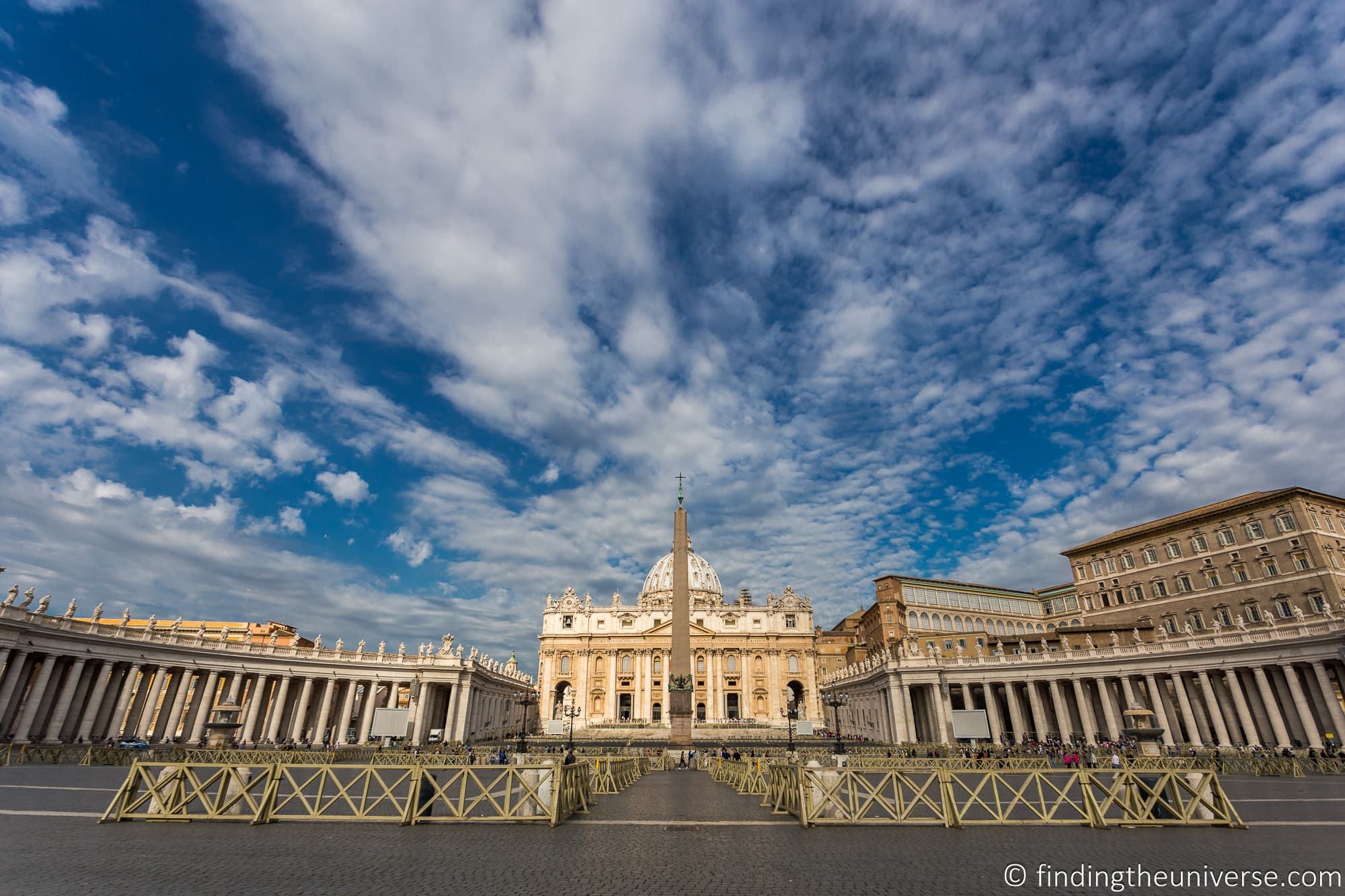If you are planning to visit Rome, then we think a trip to the Vatican is a must. This is one of the most popular tourist destinations in the city, and one we have been lucky enough to visit several times over the past 20 years.
There is a huge amount to see and do at the Vatican, as well as many options for visiting and purchasing tickets for the various attractions at the Vatican.
It can be a bit overwhelming trying to figure out how to visit, as well as what to see and do when you visit the Vatican.
In this guide we’re going to share with you everything you need to know to plan your visit, from the best time to visit, to how to skip the lines, to the highlights you must not miss when you visit.
We’ll also tell you the best places to get Vatican tickets, share some of our favourite guided tours, share practical information for your visit, and much more. Once you’re finished reading, you’ll be fully prepared for your Vatican visit!
Let’s start with an overview of the Vatican.
What is the Vatican?
The Vatican, or Vatican City, is an independent city-state found within the city of Rome, Italy. It is the headquarters of the Roman Catholic Church and is home to and ruled by the Pope.
Vatican City is also the location of a number of popular attractions, including the Vatican Museums, St. Peter’s Basilica, St. Peter’s Square, and the Sistine Chapel. It is both a pilgrimage site for Catholics as well as a place that appeals to all types of visitors interested in the architecture and world-class art that is found within the museums and churches here.
It’s worth noting that when people talk about “the Vatican”, they are normally referring to either Vatican City or the Vatican Museums within, which can be a bit confusing.
For clarity, this guide will cover all the attractions inside Vatican City which includes the Vatican Museums.
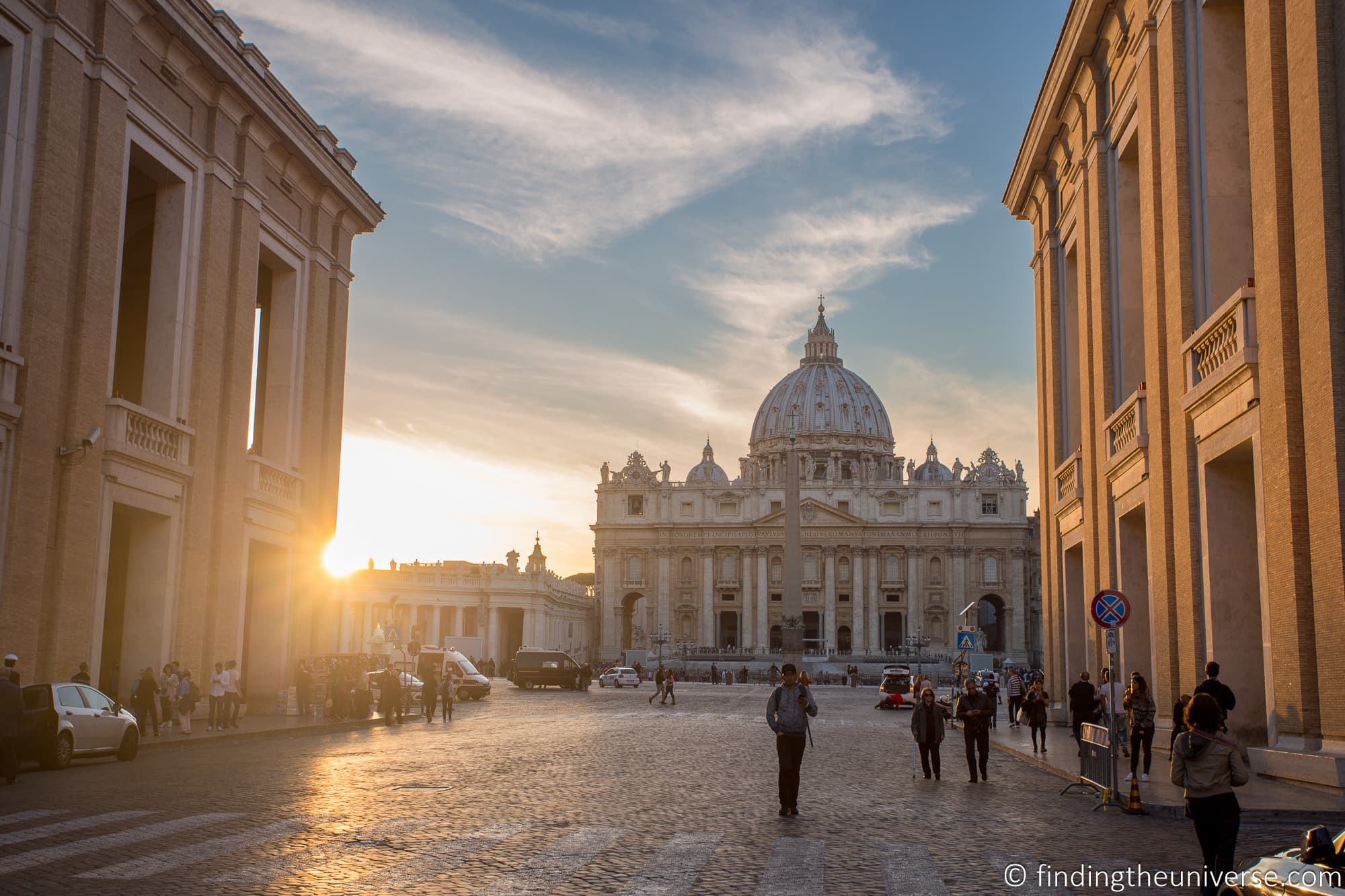
An Overview of the Vatican
The Vatican (formally the Vatican City State) was established in 1929 at the signing of the Lateran Treaty, which helped resolve a long-running issue concerning the power of the Pope in Italy.
It is named after Vatican Hill, where it is located, which is one of the traditional seven hills of Rome. The name “Vatican” dates back to Roman times.
Vatican City is 49 hectares (121 acres) in size, with a population of under 500 people.
The Vatican is ruled by and home to the Pope, who is both the bishop of Rome and head of the Catholic Church. The Pope lives in the Papal Apartments in the Apostolic Palace, also known as the Vatican Palace and the Palace of Sixtus V in honor of the Pope who oversaw the majority of its construction.
As well as the Papal Apartments, the huge Apostolic Palace is also home to the Vatican Museums, the Vatican Library, the Sistine Chapel, the Raphael Rooms, and the Borgia Apartments.
The other main sight in the Vatican is St. Peter’s Basilica and St. Peter’s Square. St. Peter’s Basilica is the largest church in the world and an architectural masterpiece, and the square in front is also very impressive.
About half of Vatican City is taken up by the Vatican Gardens, a large private garden area which is home to a number of buildings such as the Vatican Radio building and the Palace of the Governorate.
Many areas of the Vatican, such as the Vatican Museums and St. Peter’s Basilica, are open to the public and can be visited. Other areas, such as the private apartments of the Pope, are not open to visitors. In this guide we’ll cover all the areas of the Vatican and your options for visiting them.
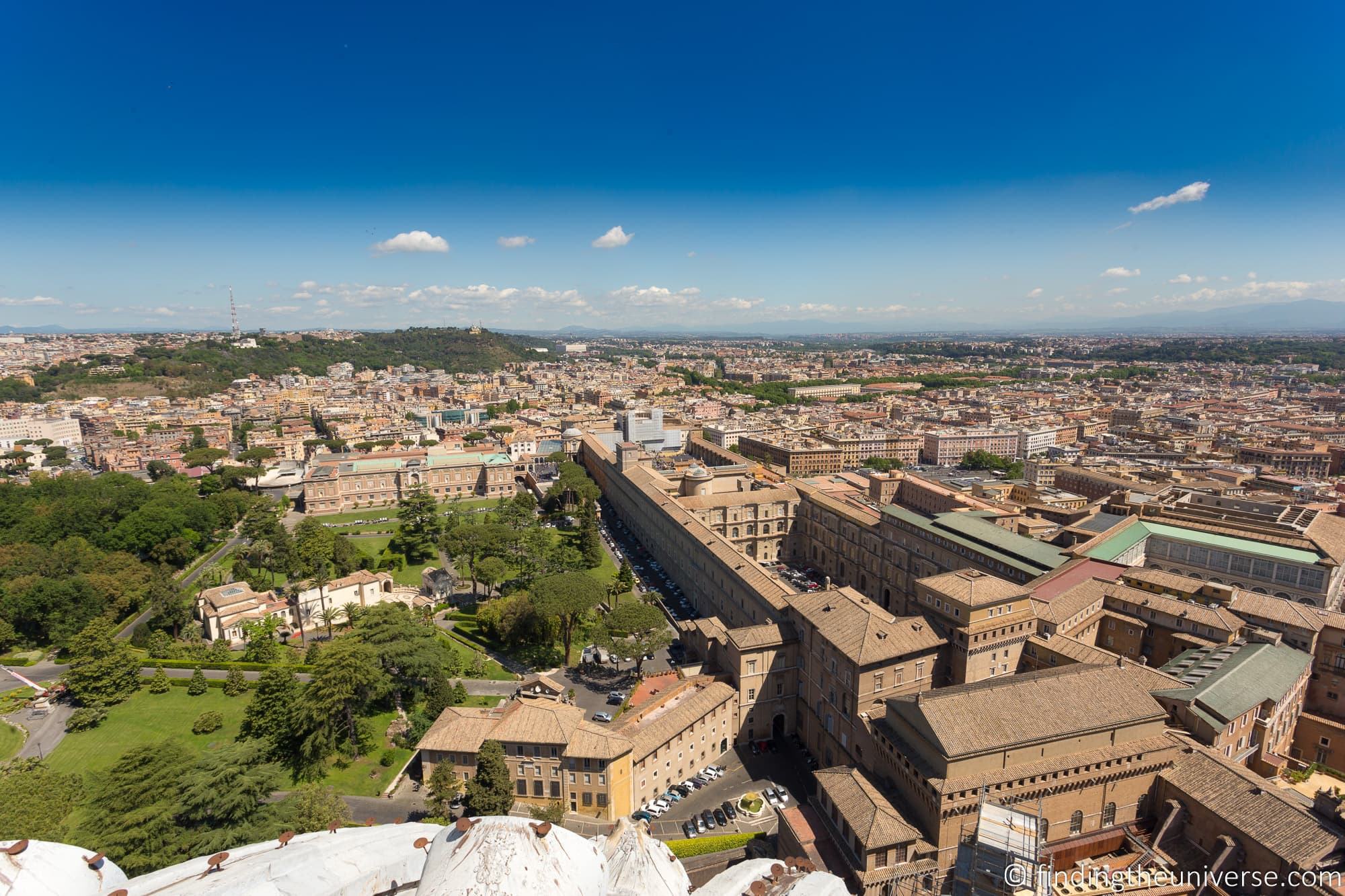
Where is the Vatican?
The Vatican, or Vatican City, is within the city of Rome, Italy. In fact, Rome entirely surrounds the Vatican City. It is located to the west of the Tiber River. You can see it on Google Maps here.
How to get to the Vatican
Found in Rome, the Vatican is relatively easy to get to. Just bear in mind that the Vatican covers an area of around 49 hectares (121 acres), so you will want to plan accordingly depending on which part of the Vatican you wish to visit.
For example, the access to the Vatican Museums is at the north side of Vatican City (here on Google Maps), whilst St. Peter’s Basilica is towards the south of the city (here on Google Maps).
There are a number of options for reaching the Vatican. These include walking, the metro, taking a public bus, taxi, or the hop on hop off sightseeing bus.
First, it is relatively easy to walk here. From Piazza Navona for example it is 20 minutes’ walk to St. Peter’s Basilica, or 30 minutes’ walk to the Vatican Museums entrance.
The closest metro station to the Vatican is Ottaviano, which is a 7-minute walk to the Vatican Museums entrance or a 10-minute walk to St. Peter’s Basilica. Ottaviano is on the red line, which connects you to locations such as the Spanish Steps and Rome’s Termini station (where you can transfer to the blue line for the Colosseum for example).
Numerous public bus routes also pass by the Vatican from all over the city. It is also easy to take a taxi or use a ride-sharing app to get to the Vatican. Just be sure to specify exactly where you intend to go in the Vatican so they can drop you at the closest drop-off point.
Finally, a number of hop on hop off buses in Rome include the Vatican as one of their stops, so if you are using one of these services this is also an option.
If you have an attraction pass such as the Omnia Vatican and Rome Card, many of these include either a public transit card or sightseeing bus that you could use to visit the Vatican.
Vatican Opening Times
The Vatican is a country but here are no gates or security controls to cross from Rome to Vatican City, and you probably won’t even notice when you do. So you can visit it whenever you want although most indoor attractions are only open during the daytime.
A number of the attractions within the city-state do have specific opening times, which are as follows.
Vatican Museum Opening Times
The Vatican Museum is usually open as follows:
- Monday – Saturday 9am – 6pm (last entry at 4pm)
From 14th April 2023 – 28th October 2023, there are extended opening hours on Fridays and Saturdays, until 10.30pm (final entry 8.30pm).
The Vatican Museum is closed on Sundays with the exception of the last Sunday of the month when it is open from 9am – 2pm (last entry 12.30pm). On these days entry is free.
In addition, the Vatican Museum is also closed on the following days in 2023:
1st & 6th January, 11th February, 10th April, 1st May, 29th June, 15th & 16th August, 1st November, 8th, 25th, 26th and 31st December.
For more information on opening times and closing times, see the official website here. Note that there are multiple sites with information on the Vatican Museums, but the only official site is https://www.museivaticani.va/.
St. Peter’s Basilica Opening Times
St. Peter’s Basilica is usually open as follows:
- 1st October – 31st March: 7am – 6.30pm
- 1st April – 30th September: 7am – 7pm
Note that this is a working church and mass is regularly celebrated here. Access is normally not restricted during these times but you should be aware when it is going on and behave respectfully.
In addition, when the Pope is in Rome there is normally a Papal Audience held on a Wednesday. This is normally held in St. Peter’s Square outside of St. Peter’s Basilica in the morning from around 9am. On these days, access to St. Peter’s Basilica is normally not allowed until the audience is complete. See more about attending a Papal Audience in that section of this guide.
For more information on opening times and visiting St. Peter’s Basilica, see the official webpage from the Vatican here.
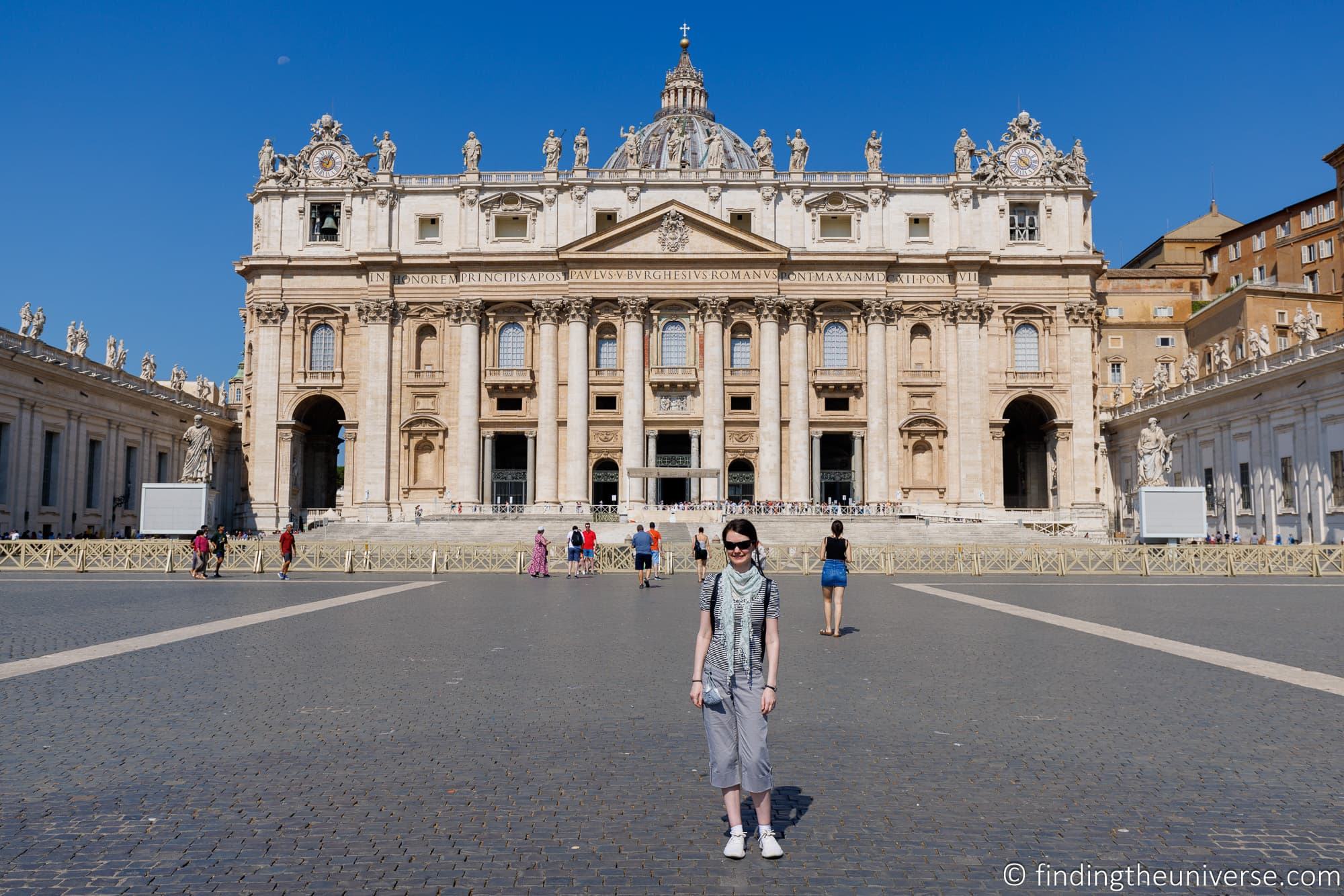
What to see and do at the Vatican
There is a huge amount to see and do at the Vatican, at least enough to spend at least half a day here if not a whole day.
Here are the main sights you can take in when you visit Vatican City.
Vatican Museums
A definite highlight when visiting Vatican City are the Vatican Museums. These are found within the Apostolic Palace, and are the main public museum of the Vatican City.
The collection, which includes a rather staggering 70,000 pieces (of which around 20,000 are on display at any one time), was founded in the early 16th century.
Today, the collection spans seven kilometers across a number of galleries. and includes paintings, sculptures, religious artifacts, and tapestries. Art from some of the world’s greatest artists is on display, including Raphael, Michelangelo, Bernini, Van Gogh, and Picasso. It’s one of the most visited museums in the world.
As you will have noticed, the Vatican Museums are plural. This is because this is not just one museum. In fact, there are 26 museums listed as being contained with the Vatican Museums complex.
However, as a visitor you will likely just feel like you are visiting one giant museum that spans numerous galleries rather than 26 museums. If you’re feeling overwhelmed and wondering what to see, see the section of this guide covering our highlights of the Vatican Museums.
The Vatican Museums require a ticket, and you can see more about buying a ticket in our guide to tickets for the Vatican City sights elsewhere in this guide. You can buy a ticket on site, but the lines are very long and we highly recommend booking a ticket in advance.
If you have a limited time or are wanting to see the highlights in around 3 hours or less, we highly recommend considering a guided tour such as this one or this one.
We took tours on our first two visits to the Vatican and found them very helpful in seeing and learning about the most important pieces and rooms without being too overwhelmed. They all include a visit to the Sistine Chapel as well.
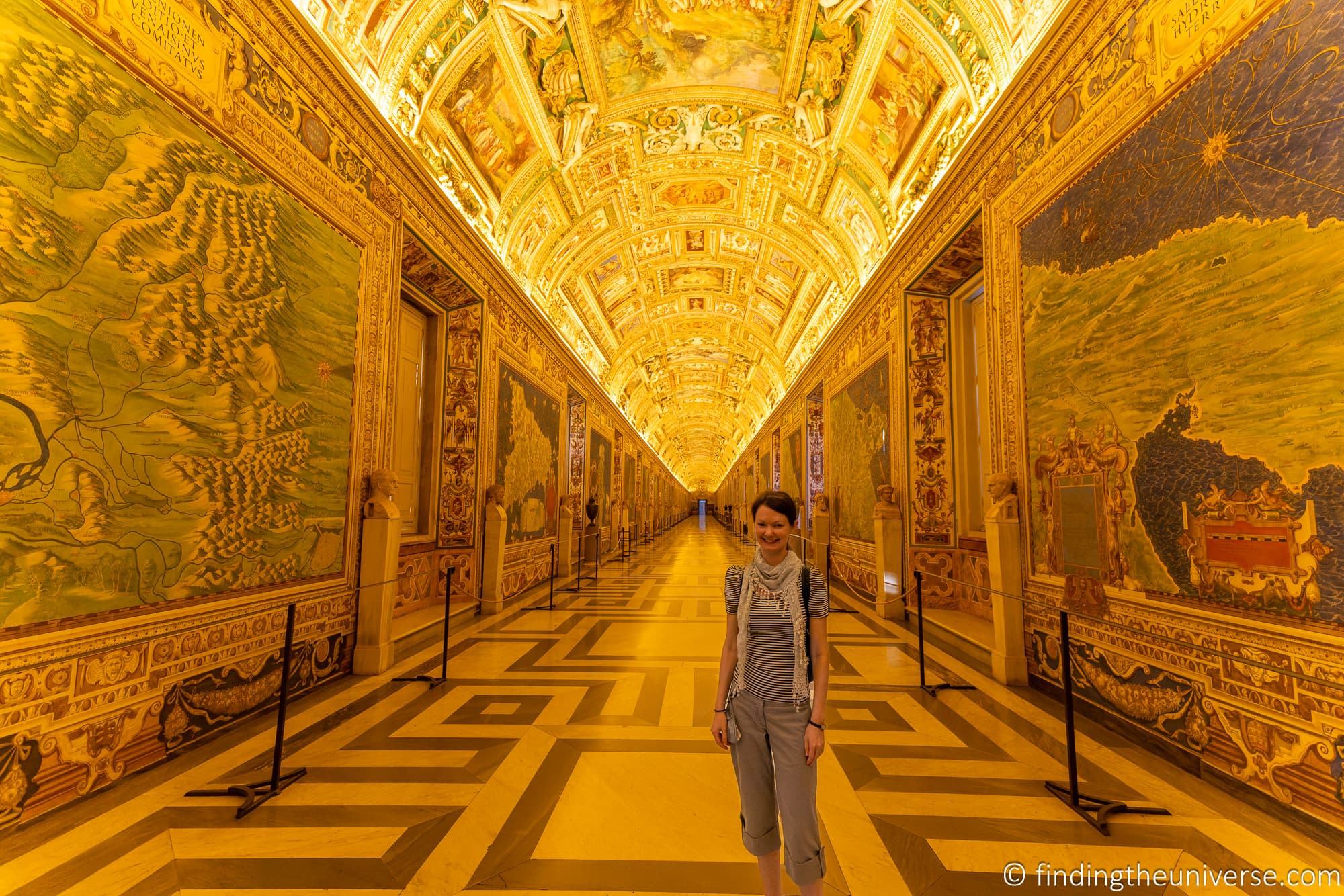
Sistine Chapel
The Sistine Chapel, or Capella Sistina, is a chapel located within the Apostolic Palace. It was built in the 15th century and named after Pope Sixtus IV. It is best known for the frescoes within, notably those done by Michelangelo (the ceiling and Last Judgement above the altar), which are often considered to be some of the best artistic work to come out of the Renaissance period.
The Sistine Chapel is also known as being where Popes are selected, in a process known as the Papal Conclave.
The Sistine Chapel has been drawing visitors for over 500 years, since Michelangelo completed his masterpieces, and is still a major attraction today.
The Sistine Chapel is found within the Apostolic Palace, and can only be visited when you visit the Vatican Museums. So to all intents and purposes it is a part of the Vatican Museums. However, it is technically separate, hence why tickets are sold as being for both the Vatican Museums & Sistine Chapel. But all Vatican Museums tickets include entrance to both.
Entry to the Sistine Chapel is included as part of a Vatican Museums ticket, and you can also book tours which give you early exclusive access such as the Pristine Sistine tour and the Key Master tour.
St. Peter’s Basilica
One of the most visually spectacular buildings in the Vatican is the Papal Basilica of Saint Peter in the Vatican, more commonly known as St. Peter’s Basilica.
Its famous dome can be seen from around Rome, and a visit to this church is a must when visiting the Vatican.
Construction began in 1506, and the church was consecrated in 1626. It replaced the fourth century Old St. Peter’s Basilica, which was built by the Roman Emperor Constantine.
St. Peter’s Basilica is impressive for a number of reasons. First, for it’s incredible size. By volume, it is the largest church in the world and it has a footprint of almost six acres.
Second, its design. It was built during the Italian Renaissance period, with help from famous artists, designers, and architects such as Bramante, Michelangelo, and Bernini. It is widely regarded as one of the foremost examples of Renaissance architecture in the world.
Third, the interior. This is filled with priceless artworks from Renaissance masters, including Bernini and Michelangelo.
Finally, St. Peter’s Basilica has enormous significance to members of the Catholic faith. Whilst it is not the mother church of the Catholic faith, it is still regarded as one of the most important of Catholic shrines. 91 popes are buried here, and it is widely believed to be the final resting place of Saint Peter himself, the head of the apostles.
Suffice to say, we think a visit to St. Peter’s Basilica is a must when you visit the Vatican. Entry is free and you do not need a ticket to visit, although you can book a tour like this or this.
There’s also the option to visit the dome for a small extra fee. As with any holy place in Italy, it is important to adhere to the dress code as otherwise entry may be denied.
See our sections in this guide on dress code, tickets and tours for more information. This guide also has a detailed section covering the highlights of St. Peter’s Basilica that you won’t want to miss when you visit.
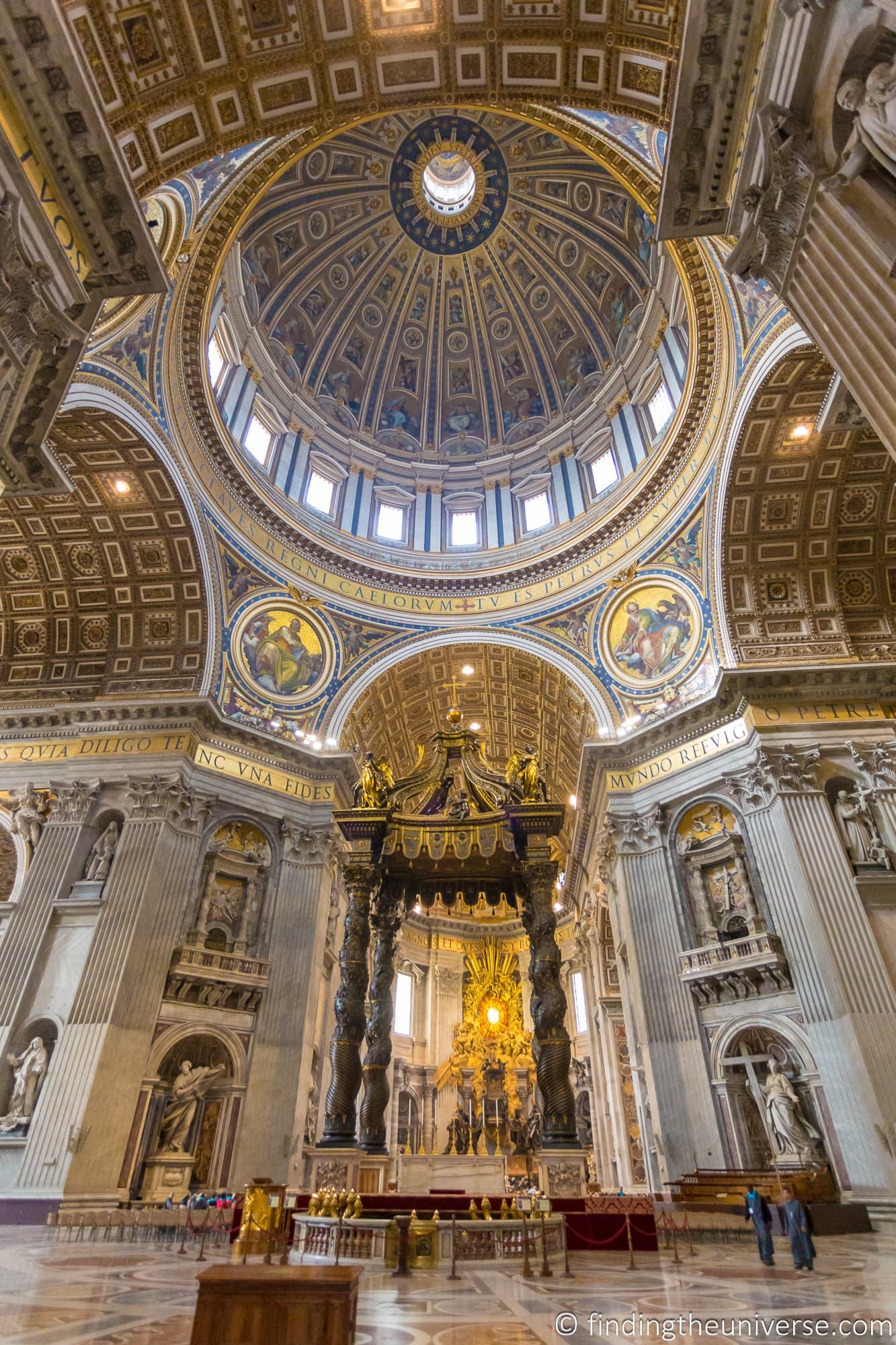
St. Peter’s Square
Directly in front of St. Peter’s Basilica is St. Peter’s Square, a large plaza whose current design was created by Bernini in the mid 17th century.
The center of the plaza is dominated by a 25.5 meter (84ft) high ancient Egyptian obelisk which was brought from the city of Alexandria in Roman times and placed in its current location in 1586.
The plaza is surrounded and almost entirely enclosed by a series of massive Doric colonnades, four deep, with the design aiming to enclose and embrace visitors in the arms of the Mother Church.
There are also a pair of fountains in the plaza on either side of the obelisk, one designed by Bernini, and an earlier one designed by Maderno.
Overall, St. Peter’s Square is a hugely impressive foreground to St. Peter’s Basilica. It is also here where Papal Audiences are most regularly held, which was one of the reasons it was designed as it is, in order to hold large crowds and provide a good view of the Pope to visitors.
St. Peter’s Square is free to visit and open all the time. During Papal Audiences it can get very busy and some sections will be closed off.

Vatican Gardens
Around half of the Vatican City is taken up by the Gardens of Vatican City, which date back to medieval times when the area was largely used for orchards and vineyards.
However, the more formal landscaped gardens that are visible today largely date to the beginning of the 16th century. Despite taking up a large part of the Vatican and being filled with beautiful sculptures and fountains, the gardens were not open to the public until 2014.
Today, it is only possible to visit the gardens as part of a guided tour. You can get a view of part of the gardens from various points whilst touring the Vatican Museums and from the top of the dome of St. Peter’s Basilica.
Underneath the Vatican Gardens there is also the possibility to visit the Necropolis of the Via Triumphalis, a Roman-era cemetery which was discovered in 2003. Note this is different from the visit to the Vatican Necropolis below St. Peter’s Basilica, although it is likely part of the same ancient Necropolis site.
Visiting the Necropolis of the Via Triumphalis requires a separate ticket purchase and they are not always available, check the official ticket site for options.
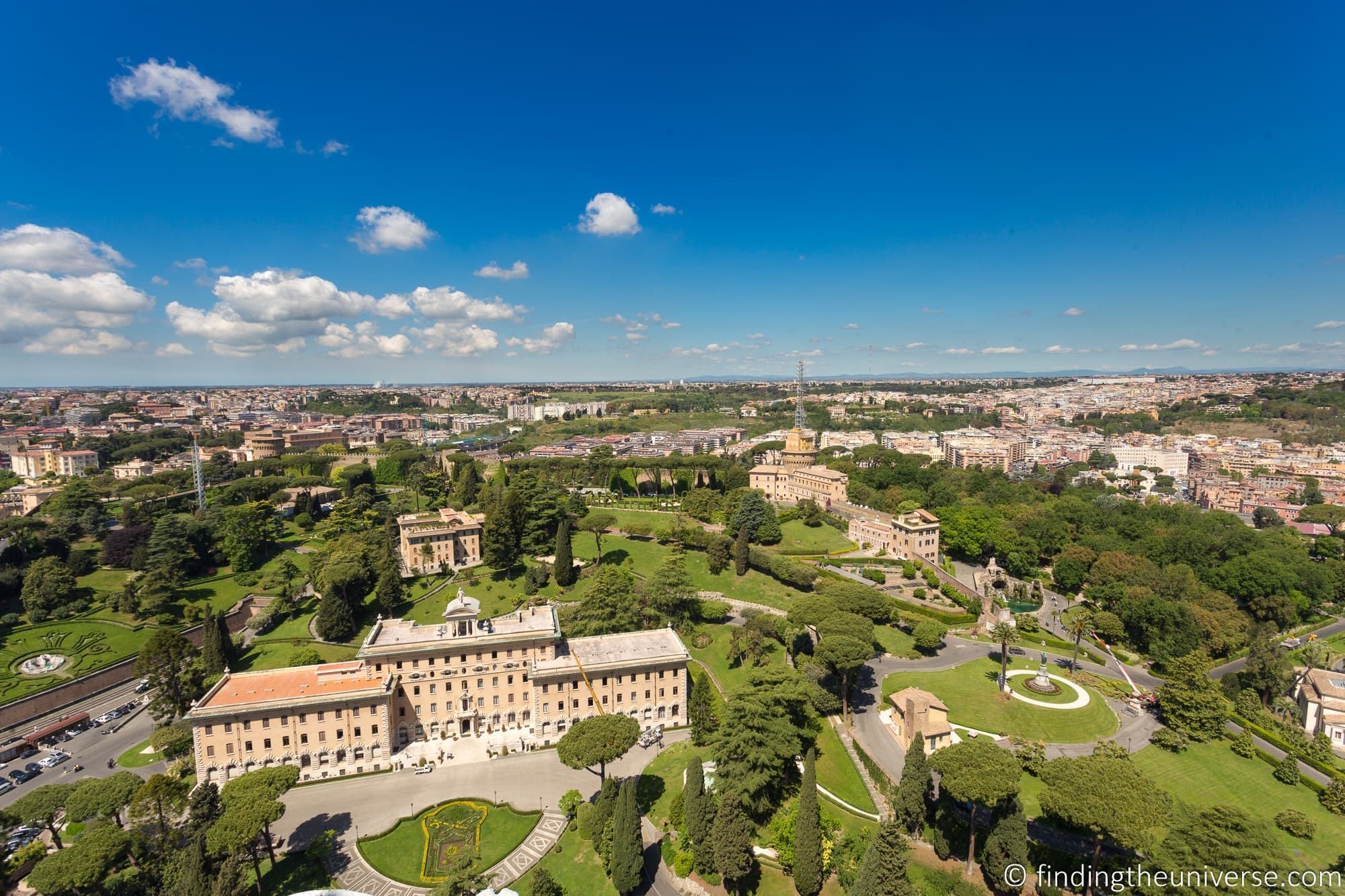
Vatican Grottoes
The present-day St. Peter’s Basilica, as previously described, was built atop a fourth century building known as the Basilica of Constantine.
That basilica was in turn built upon a Roman-era cemetery, or Necropolis, which we will cover in a separate section as it is visited separately. Rome, as you will quickly learn when you visit, is a city of many layers!
Construction of the new St. Peter’s Basilica did not completely destroy the old Basilica, which can still be visited today.
The parts of the Constantine Basilica which can be visited are generally known as the Vatican Grottoes, or Vatican Caves. It’s not quite an accurate name because what you are actually visiting is the original basilica, but that’s the name that is used.
The Vatican Grottoes are also sometimes called the Vatican Crypt and Catacombs.
Within the Vatican Grottoes you can see the ancient basilica, complete with chapels, funerary monuments and artworks. This is also where a great many popes are buried, along with some European Royalty, as they wanted to be near the final resting place of St. Peter.
Just note that St. Peter’s tomb is not actually in the Vatican Grottoes, it is in the Vatican Necropolis, which is below the Grottoes and accessed separately on a special tour. See the next section for details of that.
Access to the Vatican Grottoes is free, although tours which include it are available, like this one. The entrance to the Vatican Grottoes is inside St. Peter’s Basilica. It’s near the high altar at the Pier of St. Andrew. Note that there may be a line to visit the grottoes, and photography is not allowed in the grottoes.
Vatican Necropolis
The Vatican Necropolis (also known as the Scavi, which means excavation in Italian), is a large cemetery area found underneath St. Peter’s Basilica. It’s below the Vatican Grottoes and accessed separately.
The Necropolis (literally, city of the dead) dates from the Roman Empire, and was built here because Roman law at the time decreed that the dead must be buried outside the city walls.
In the 1940s, the Vatican set out to find the tomb of St. Peter, the apostle for whom St. Peter’s Basilica is named. He, along with many other Christians of the time, was martyred at the Circus of Nero. This Circus was found essentially where the present-day St. Peter’s Basilica and St. Peter’s Square are situated.
There was a widely held belief that St. Peter was buried near the location of his martyrdom, and so the Vatican set out to discover this grave. A number of mausoleums were discovered, and in 1968 the Pope announced that the tomb of Saint Peter had officially been discovered.
Today, the Vatican Necropolis underneath St. Peter’s Basilica can be visited as part of a special guided tour. The tour takes you under the Basilica (and the grottoes) and essentially back in time to an ancient Roman cemetery where you see the old mausoleums, as well as what is believed to be the final resting place of St. Peter.
Normally, as you exit the tour you also go through the Vatican Grottoes and then up into St. Peter’s Basilica itself, which is handy as it skips what can be lengthy lines to get into the Basilica.
This tour has very limited availability, and definitely needs to be booked in advance. See the ticket section of this guide for information on how to book Vatican Necropolis tickets.
It is definitely a unique experience if you have the extra time, however there are only 250 spaces per day so you will want to book as far in advance as you can if this is of interest.
Attend a Papal Audience
As the Vatican is home to the Pope, one reason many people come to visit is to actually see him. The best way to do that is to attend a Papal Audience, also known as a General Audience.
This isn’t a mass, instead, it’s basically an audience with the Pope. He normally gives a speech and says some prayers, and often gives out blessings.
The Papal Audience is free to attend, and is held on Wednesdays when the Pope is in residence. It is held either in front of St. Peter’s Basilica (during warmer times of year), or in the Paul VI audience hall (normally in the winter months and in times of bad weather).
It is absolutely vital that you get a ticket for the Papal Audience, as you cannot just show up. Tickets are free, and we have a detailed guide to getting them in the ticketing section of this guide.
The Papal Audience starts at 9am, however you will have to go through security, and seating is on a first come first served basis. There are also capacity limits, so even if you have a ticket, once the venue is full admission is closed.
As such, we recommend arriving between 7am and 7.30am to be sure of a good seat. In the busier summer months, it is recommended to arrive even earlier if you want a good view.
Note, you can also catch a glimpse of the Pope during the Sunday Blessing, or Angelus. When the Pope is in Rome he appears at his Papal Palace window at noon for around 15 minutes to bless those in St. Peter’s Square.
All you have to do is show up, no tickets are required for this event. It will be quite busy and it’s going to be a brief, distant view, but it is an option as well.
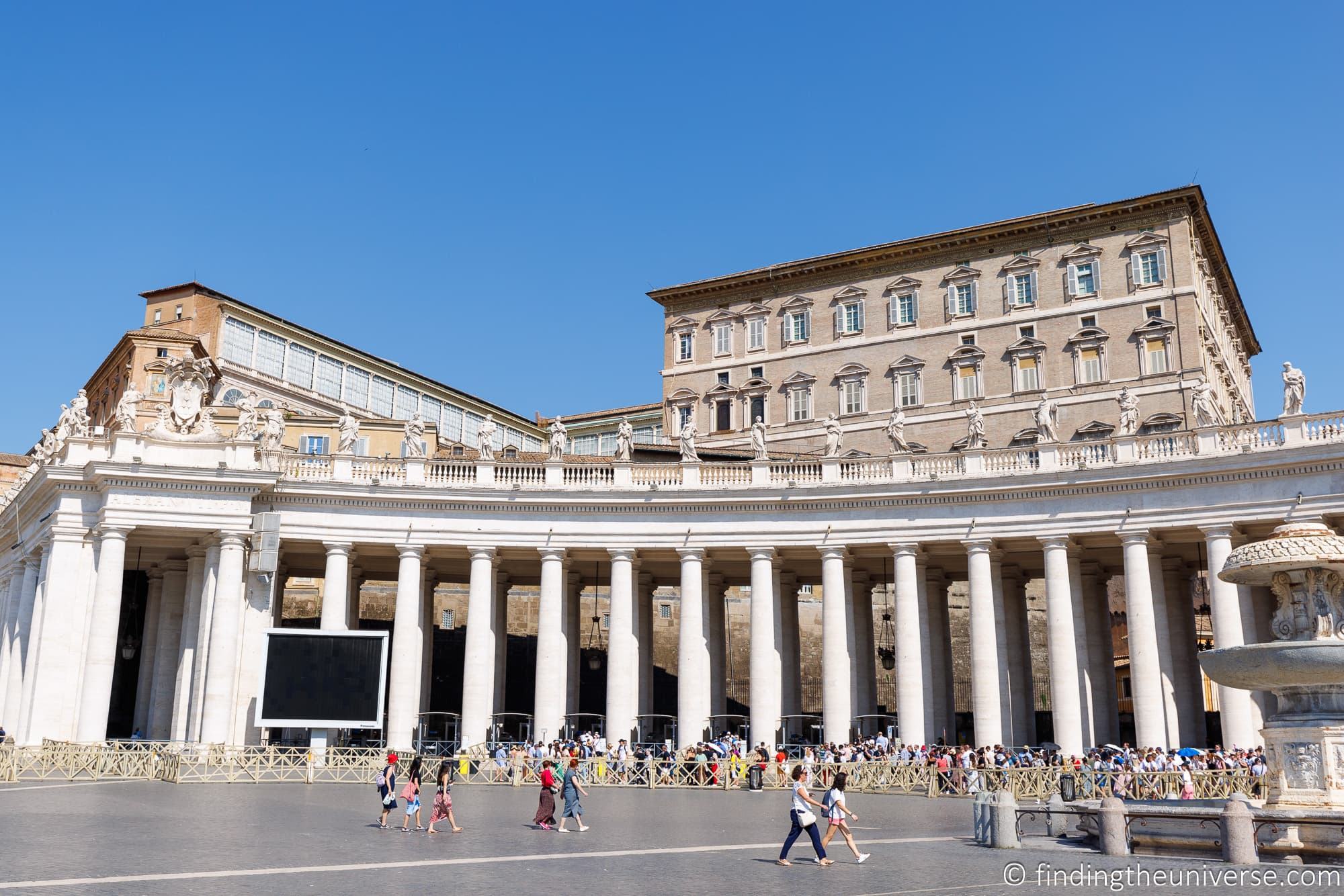
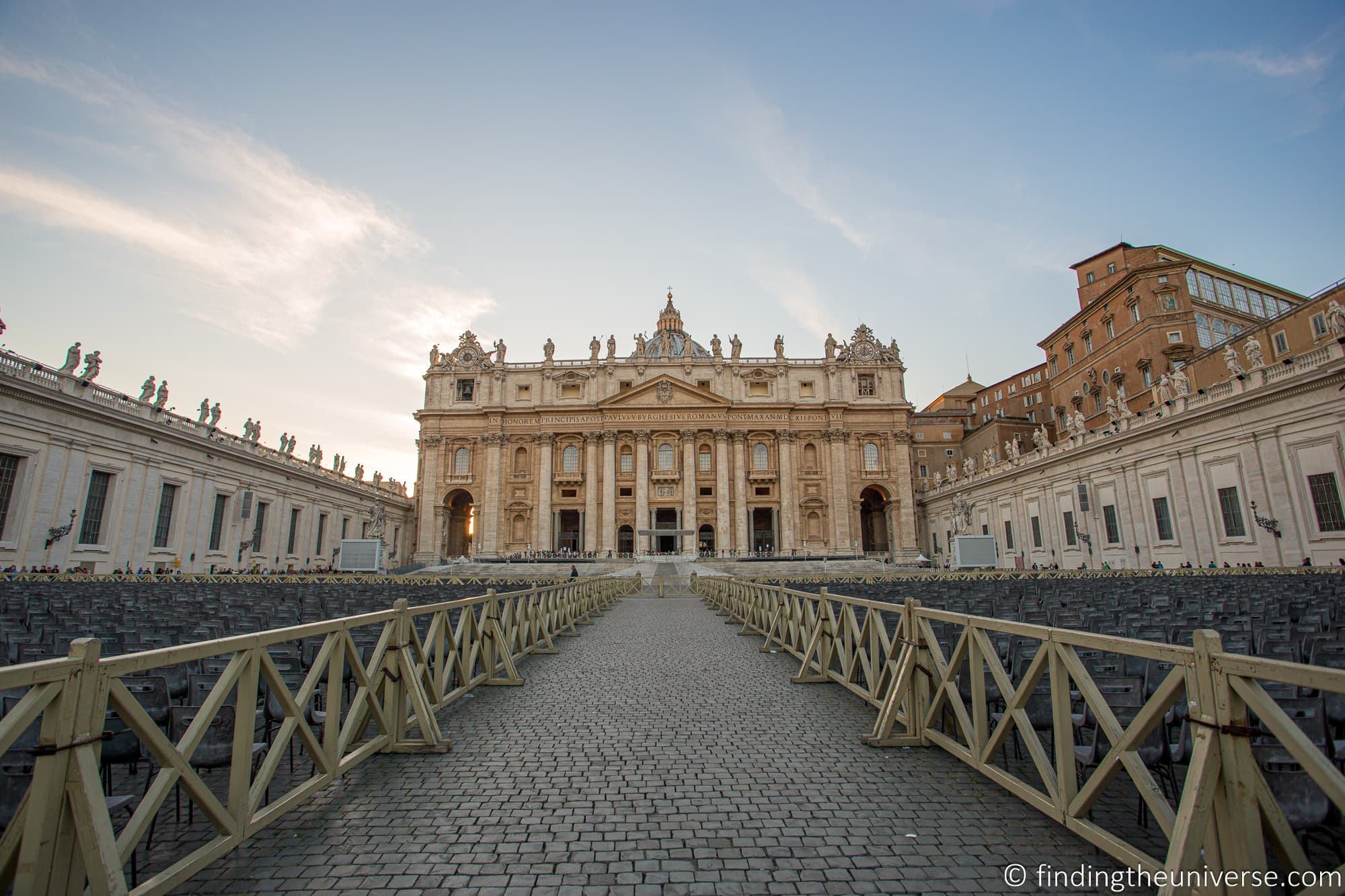
Attend Mass
Another popular option when visiting the Vatican is to attend mass.
The best place to do so is at St. Peter’s Basilica, where services are held multiple times a day. You can see the full schedule of services on this page. These services do not require booking, you just need to show up at the Basilica.
Depending on when you visit Rome, there is also the possibility to attend a Papal Mass, which is a mass led by the Pope. These are also known as Liturgical Celebrations.
A Papal Mass is a less regular event than a Papal Audience, normally held to celebrate a special event such as Christmas or Easter. They are held either inside St. Peter’s Basilica or on St. Peter’s Square. They may also be held in one of the other basilicas in Rome (you can see a list of these here).
As with a Papal Audience, you need a ticket for a Papal Mass. These are also free.
The procedure for booking a Papal Mass is the same as for booking a Papal Audience. You can check when there are Papal Masses on this Vatican page for 2023.
Note this page is normally updated around a month in advance, however for particularly popular masses (Easter and Christmas specifically) you will want to book as far in advance as possible. The dates may not be shown on the calendar, but there is normally a mass held on Palm Sunday, Easter Sunday, and on Christmas Eve.
Use the Post Office
The Vatican, as already mentioned, is a country unto itself. That means it has all the things you would expect to find in a country, including its own postal system.
There is a post office open to all found on St. Peter’s Square, and there is also one near the giftshop just before you exit the Vatican Museums.
If you are looking to send a postcard or mail from your trip, we think doing so from the Vatican post office is a great idea. Jess always send a postcard from the Vatican to her grandmother.
The stamps and postage mark are obviously unique, and in our experience anyway, the mail service is much more effective than the Italian postal system! Our international postcards mailed from the Vatican arrived weeks before the ones we mailed from Italy!
You can find out more about the Vatican post office, including opening hours and tariffs, on the official Vatican post office website.
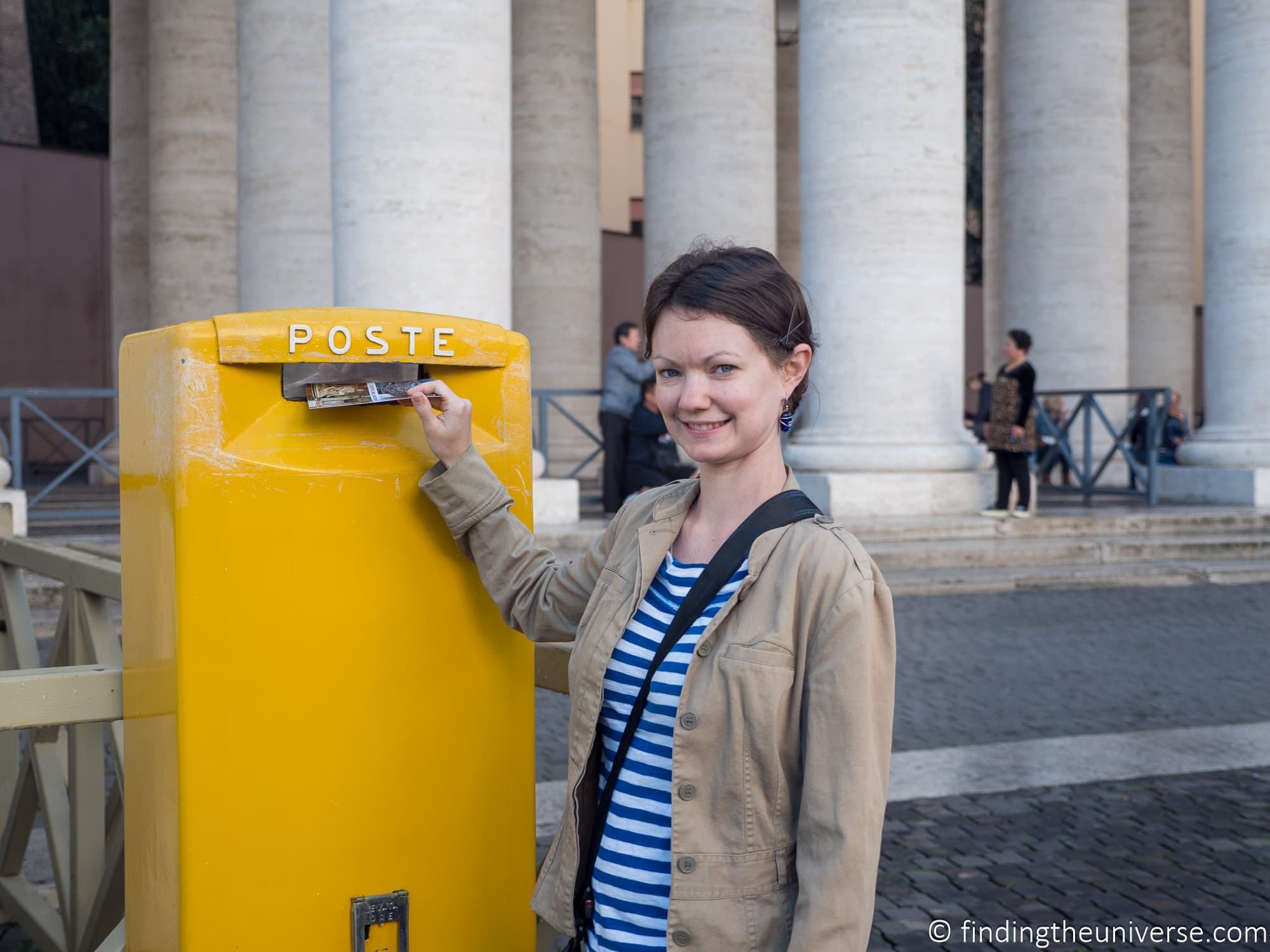
Highlights of the Vatican Museums
With 20,000 objects on display, you could literally spend weeks exploring the Vatican Museums collection. However, as you probably don’t have weeks, we’d recommend focusing on some of the highlights for your first visit.
Whilst there are countless highlights to choose from, and you can of course make your own selection, we’d recommend at least seeing the following when you visit. We would also recommend visiting the official site which has a list of masterpieces in each of the main museums.
We’d also honestly recommend taking a guided tour like one of these if you can, because there is so much to see and understand here, and a good guide can really bring what you are seeing to life.
See more on tours in the section on tours in this guide.
Below are some of our favourite parts of the Vatican Museums. These are all accessible with a standard ticket. There are other areas of the Vatican that we love that require a special ticket, like the Bramante staircase, but we wanted to focus on the general access areas for the highlights.
If you would like to plan a route before you visit, we suggest downloading the free Vatican Map from the official Vatican website here. This map is also available for free from the Vatican ticket office.
Sistine Chapel
The Sistine Chapel is definitely one of the highlights of a visit to the Vatican Museums. This chapel, named for Pope Sixtux IV who had it commissioned, is world famous for its incredible frescoes.
The most famous of these frescoes are those painted on the ceiling, and the one above the altar. They were both created by the Renaissance master Michelangelo.
The frescoes on the ceiling depict the creation of Earth as told in the Book of Genesis. This story is told in nine panels, starting with The Separation of Light from Darkness and finishing with the Drunkenness of Noah. Perhaps the most famous of these is the Creation of Adam panel, which depicts God giving life to Adam.
The frescos above the altar depict the Last Judgement, essentially the Second Coming of Christ and the separation of sinners from the saved.
There is of course more to the Sistine Chapel than the incredible frescoes by Michaelangelo. The other walls are also all decorated, with artwork from Boticellii, Perugino and Ghirlandaio to name but a few. As you would expect, these also depict various religious scenes.
A visit to the Sistine Chapel is a must when visiting the Vatican. It is not a huge space but it does tend to get fairly crowded as the day goes on.
This is also one of the few places in the Vatican Museums where photography is strictly prohibited. We have seen people escorted out for violating this rule, so we’d suggest just enjoying the incredible art on display, and then if you want a memento, buy a postcard on your way out from the Vatican Gift Shop.
If you want a special experience of the Sistine Chapel with fewer people, then we recommend taking an early access tour.
We have done both the Pristine Sistine tour and the Key Master tour (see our Key Master Tour review here), both of which get you into the Sistine Chapel earlier than normal for a much more peaceful experience.
Gallery of Maps
One of my personal favourite attractions in the Vatican Museums is the Gallery of Maps, or Galleria delle carte geografiche. This is located on the west side of the Belvedere Courtyard.
The Gallery of Maps is essentially a 120 metre long, six metre wide corridor. On the walls, 40 maps depict the main regions and cities of the Italian Peninsula.
These date from the 1580s and were painted by the friar and geographer Ignazio Dante at the request of Pope Gregory XIII.
He wanted to be able to “travel” to the different Italian states on the Italian peninsula (Italy was not a single country at that point) without actually have to leave the Vatican, and the incredibly detailed maps allowed him to do so.
A visit to the Gallery of Maps is always a highlight of our time in the Vatican Museums, and one we highly recommend.
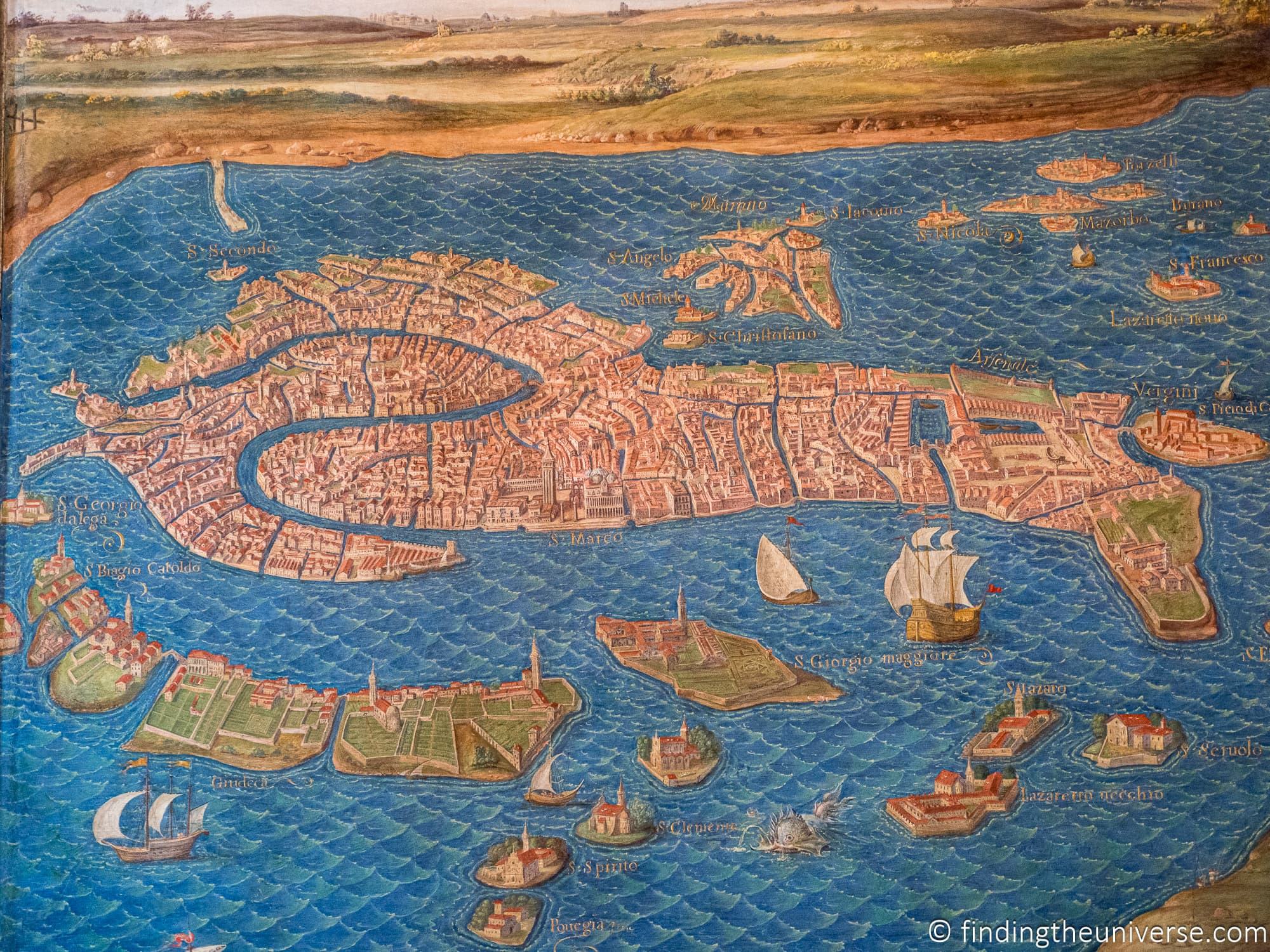
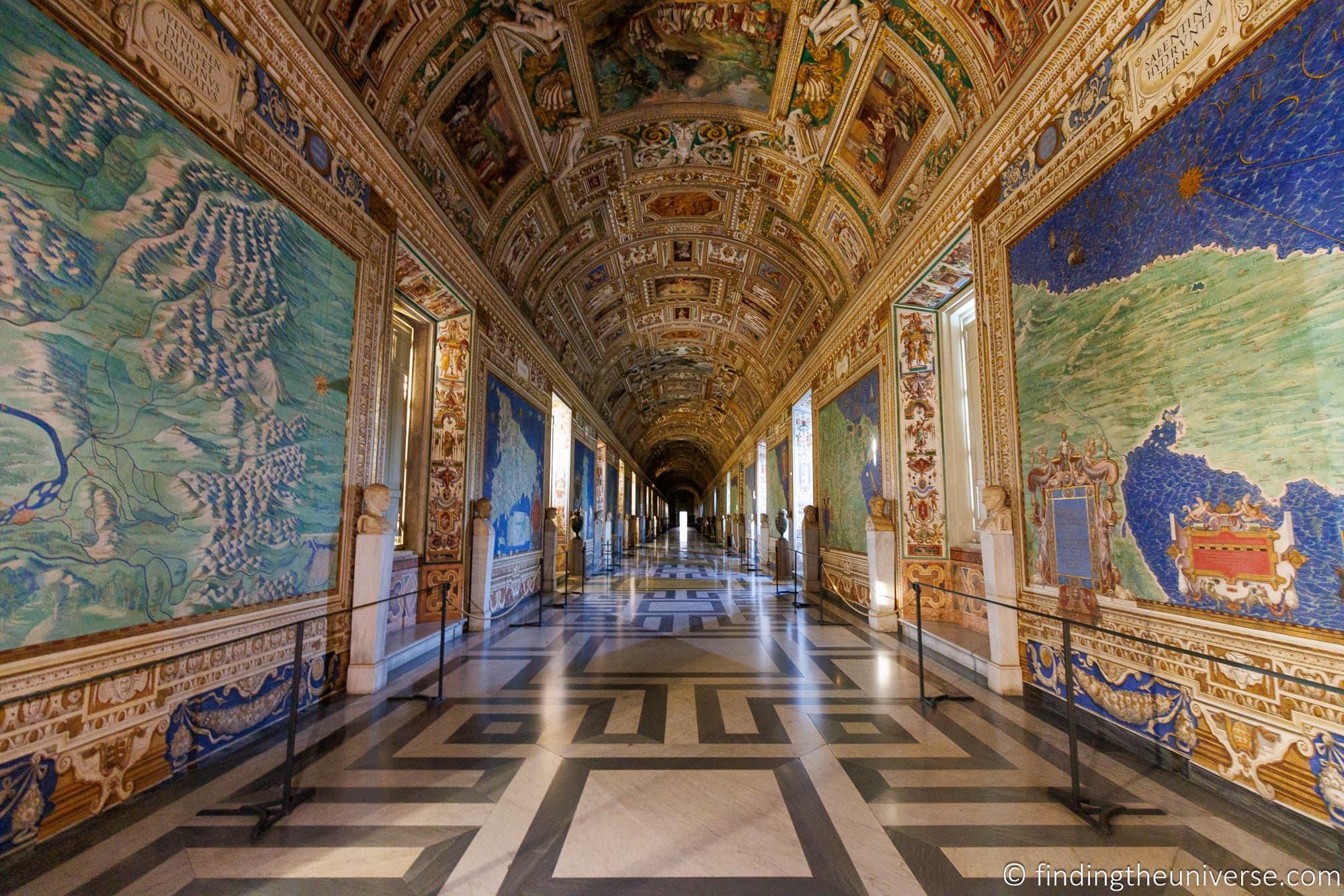
The Borgia Apartment
The Borgia Apartment is a series of six rooms in the Vatican Museums which were commissioned by Pope Alexander VI in the late 15th century. He was from the Borgia family, hence the name given to the apartments.
Alexander VI engaged the Italian painter Pinturicchio to decorate the six rooms with frescoes, which feature a range of subjects, from Old and New Testament scenes through to depictions of the planets.
Some of the frescoes also references notable events of the time, including what is believed to be one of the first depictions of a Native American in Europe. The frescoes were painted around the time that Columbus returned from the New World, and “The Resurrection” in the Room of Liberal Arts contains these depictions.
Alexander’s legacy as Pope was somewhat tarnished by his various affairs. In fact, the word Borgia became a common term for a lack of morals, corruption and nepotism.
After his fairly gruesome death (believed to be poisoning), the Borgia Apartments were sealed, and only re-opened and restored in the 19th century by Pope Leo XIII.
Today, the six apartments feature the original frescoes which have been restored. They also house part of the Vatican’s collection of contemporary art. They can now all be visited as part of a visit to the Vatican Museums.
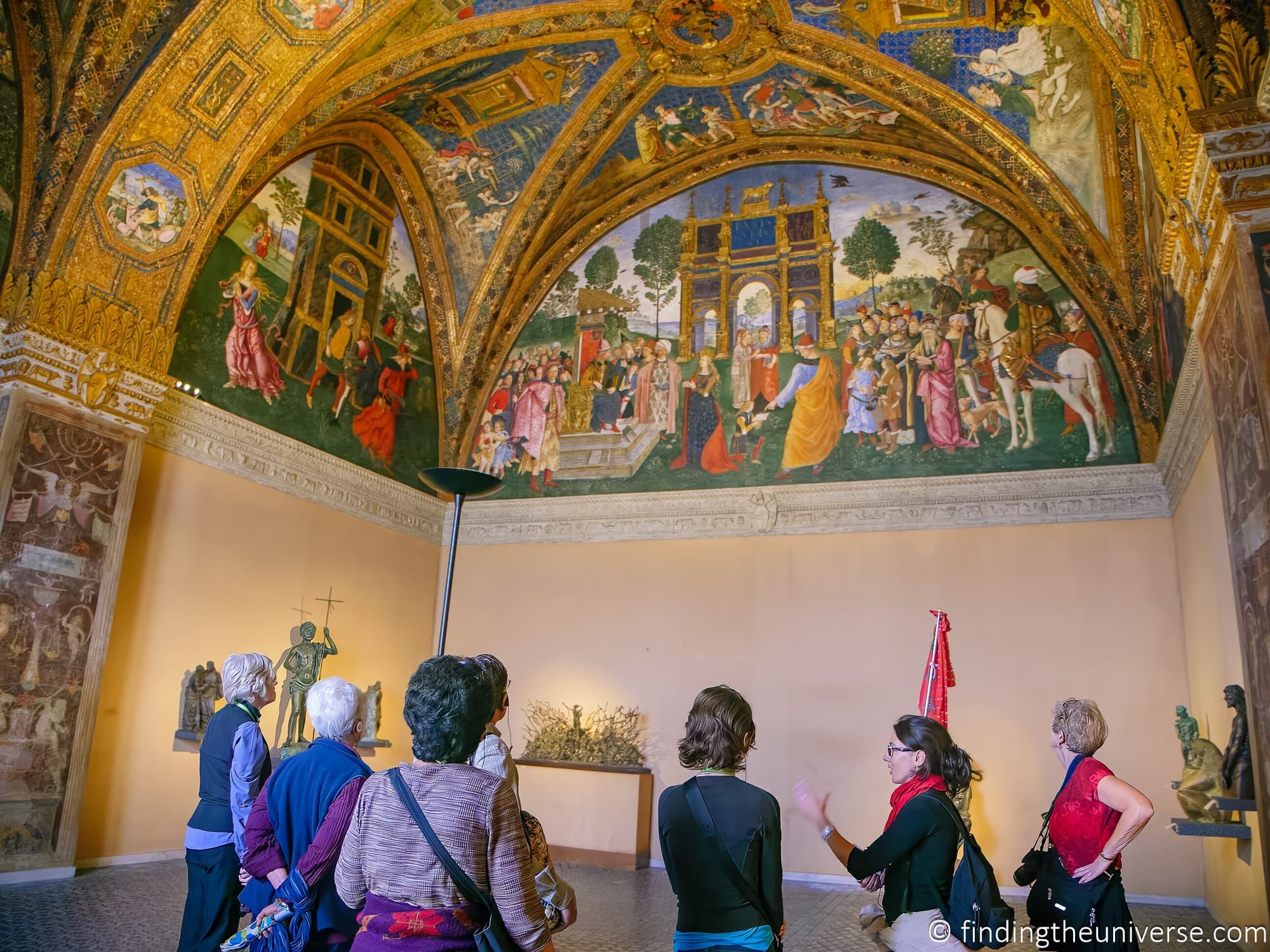
Raphael’s Rooms
There are four rooms in the Vatican Museums which are together known as the Stanze of Raphael, or Raphael’s Rooms.
These rooms were originally intended to be an apartment for Pope Julius II, with some suspecting the idea was to outdo the Borgia Apartment of Alexander VI.
Whatever the reason, he commissioned Raphael to create the frescoes in the early 16th century, starting with the library.
Unfortunately, Julius II died before they were completed, and in fact Raphael himself died in 1520 before all four rooms were completed in 1524.
However, Raphael did complete the majority of the work, with his students finishing the rest after his death.
Our favourite of the rooms was the first to be completed, which features “The School of Athens”, “The Parnassus” and the “Disputa”.
The School of Athens in particular is a highlight, and is widely regarded as one of Raphael’s best works. It has incredible perspective and there’s even a sneaky appearance by the artist himself, staring out at the viewer.
It’s definitely worth taking a tour like one of these to get the most from these paintings as there is a lot to unpack in just these four rooms!
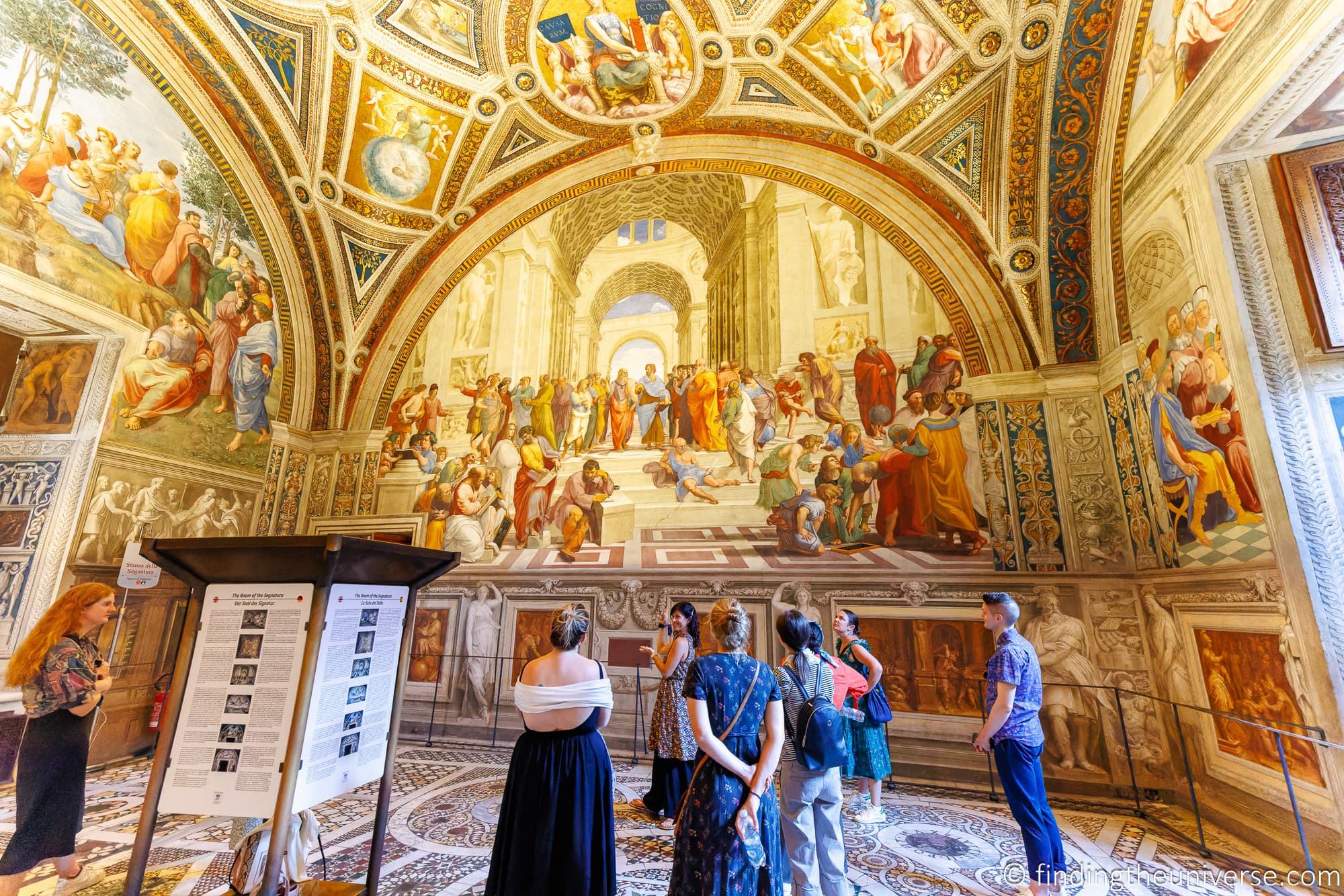
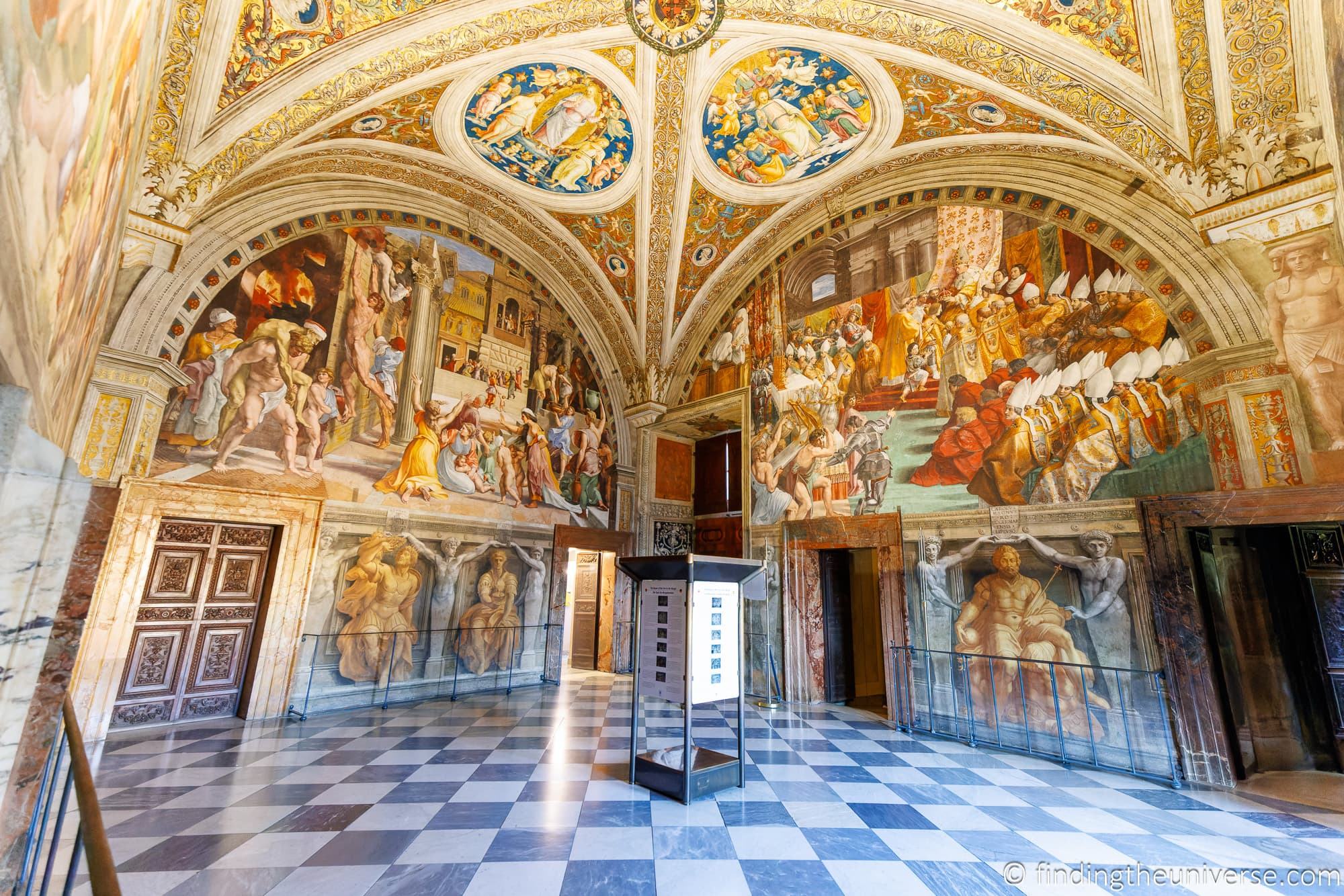
The Pinacoteca
The Pinacoteca, or Vatican Art Gallery, has been the home of some of the Vatican Museum’s most impressive art since it opened in 1932.
It’s essentially a mini art museum inside the Vatican, and you have to ensure you include it on a visit.
Across 18 rooms you will find over 400 works from some of Italy’s most well-known artists including Raphael, Caravaggio, Tiziano, Titian, and Da Vinci, to name but a few.
The museum was purpose-built to provide the best viewing conditions of the collection, whilst preserving them for future generations. It’s arranged chronologically, so as you move through the rooms you are essentially taking a tour through time from the 12th century Medieval period right up to the 19th century.
Obviously, 400 paintings are a lot, and you could honestly spend a big chunk of your time in the Vatican just exploring the Pinacoteca. But if you wanted to hone in on some highlights, consider:
Of course, there are highlights in every room. The Vatican Museum websites list their highlights by room on the official Pinacoteca website here.
The Pio Clementino Museum
The Pio Clementine Museum is home to a collection of classical sculpture, and is where some of the first objects in the Vatican Museums were displayed. Pope Julius II used this area of the Vatican in the early 16th century to display a collection of antique sculptures.
There are many highlights in the Pio Clementino Museum, but some stand out rooms and sculptures not to miss include the following.
The Octagonal Court
The Octagonal Court is a stunning courtyard found in the Pio Clementino Museum. Many of the objects on display here are still in exactly the same place they were back in the early 1500s, including the Belvedere Apollo and the statue of Laocoön and His Sons.
The Belvedere Apollo is definitely not to be missed when you visit the Octagonal Court. Depicting the Greek god Apollo, it dates from around 120AD, and is widely regarded as being one of the greatest ancient sculptures.
The statue of Laocoön and His Sons is another must-see marble statue in the Octagonal Court. This one depicts the Trojan Priest Laocoön and his sons being attacked by sea serpents. It is believed to date from around 200BC, and was put on display in the Octagonal Courtyard in 1506.
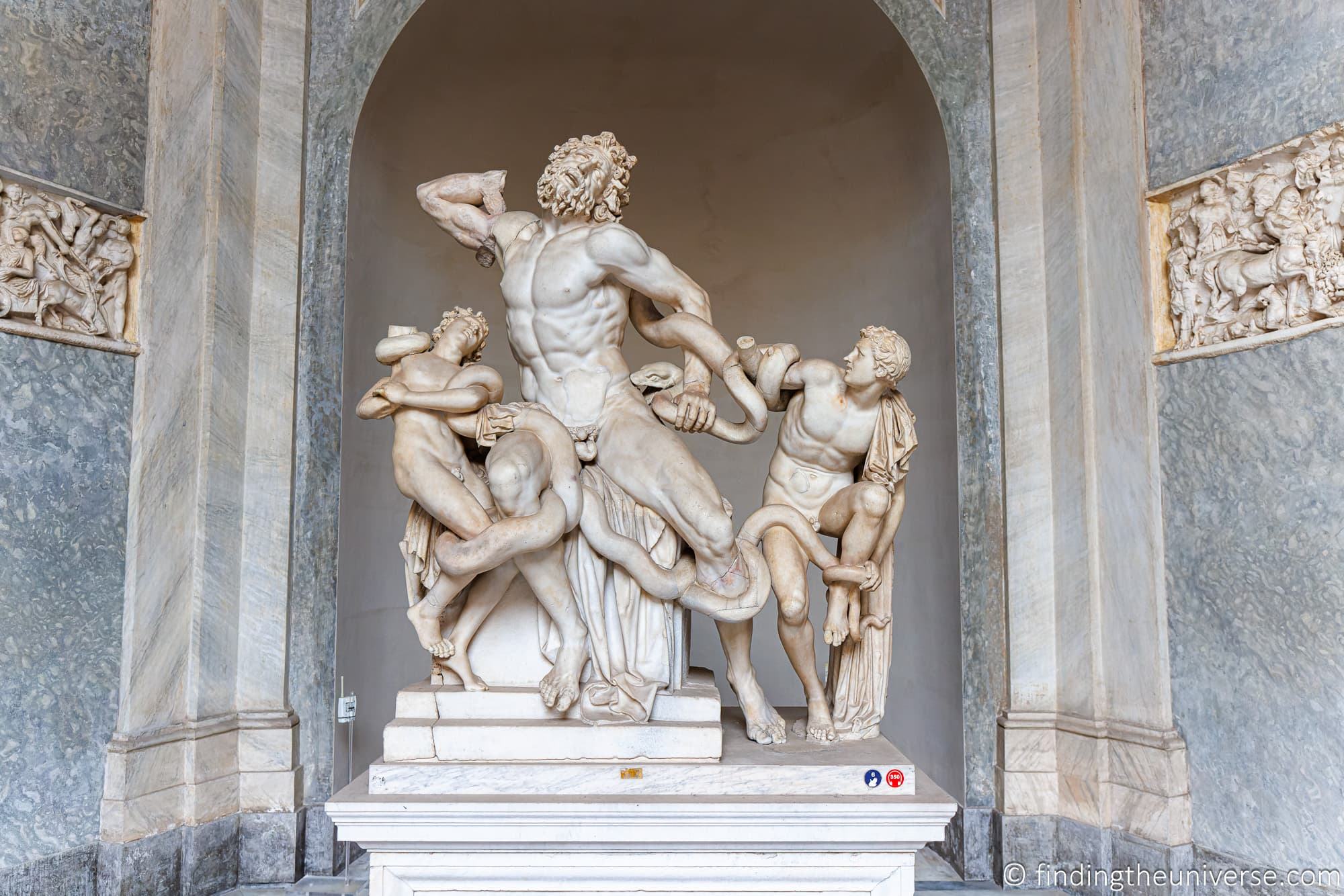
The Round Hall
The Round Hall, also known as the Round Room, is, as the name suggests, a circular room. It was designed int he 18th century in homage to the circular Pantheon.
It’s hard to miss the highlight of this room, which is a massive red porphyry basin which dates to Imperial Rome. Around this enormous basin are niches displaying huge statues.
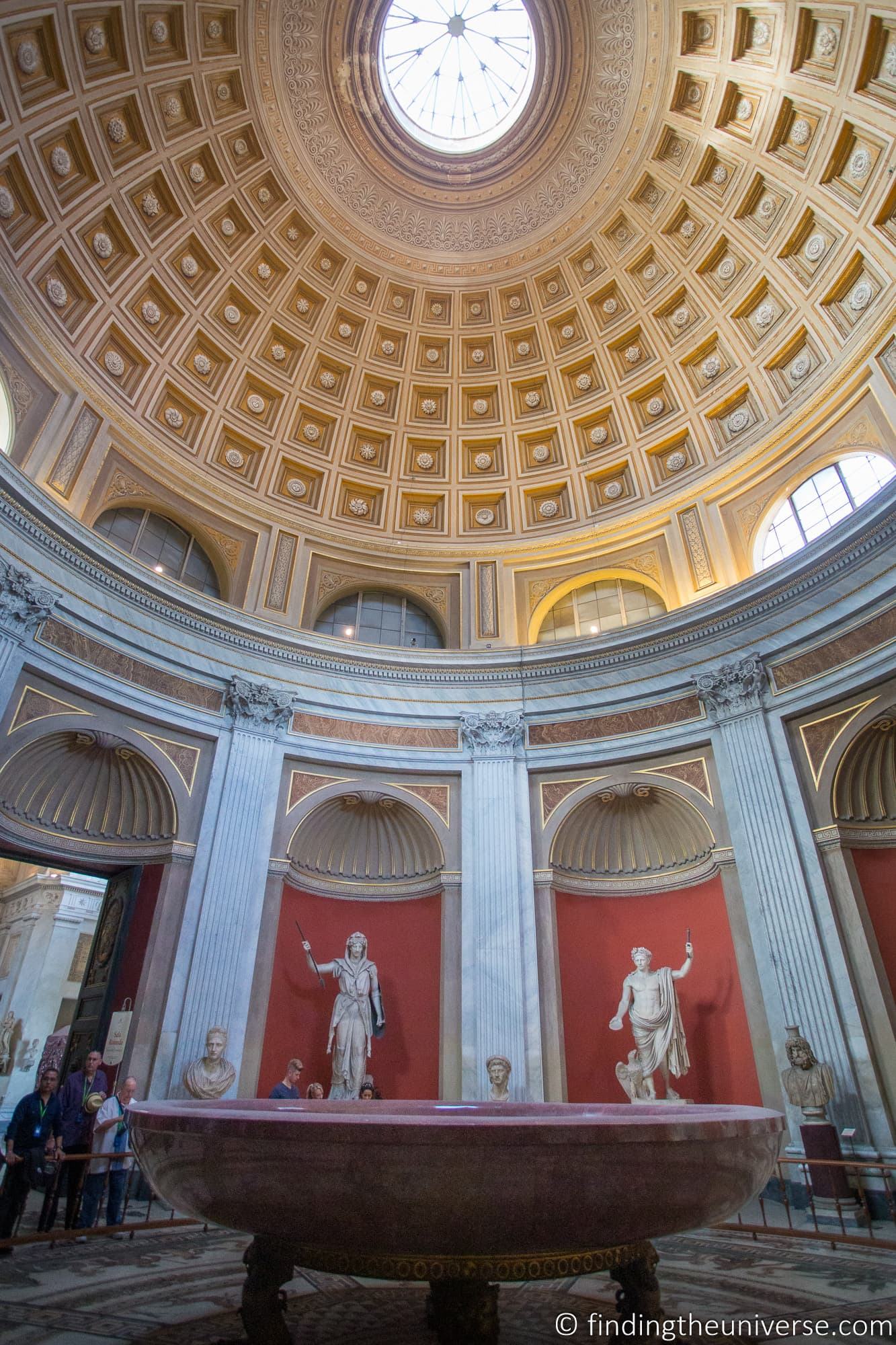
There is of course more to see in the Pio Clementino Museum, including the Gallery of Statues and the Hall of Busts, the Hall of Muses, and much more.
Gregorian Egyptian Museum
When you enter St. Peter’s Square, you will instantly notice the giant Ancient Egyptian Obelisk sitting at the centre. It’s fair to say that Imperial Rome was pretty obsessed with and influenced by Egypt.
To learn more about the relationship between Ancient Rome and Egypt, you’ll want to visit the Gregorian Egyptian Museum in the Vatican. Spread across six rooms, this museum has everything from stone tablets to artefacts relating to death. Definitely worth a visit for those with an interest in Egyptology.
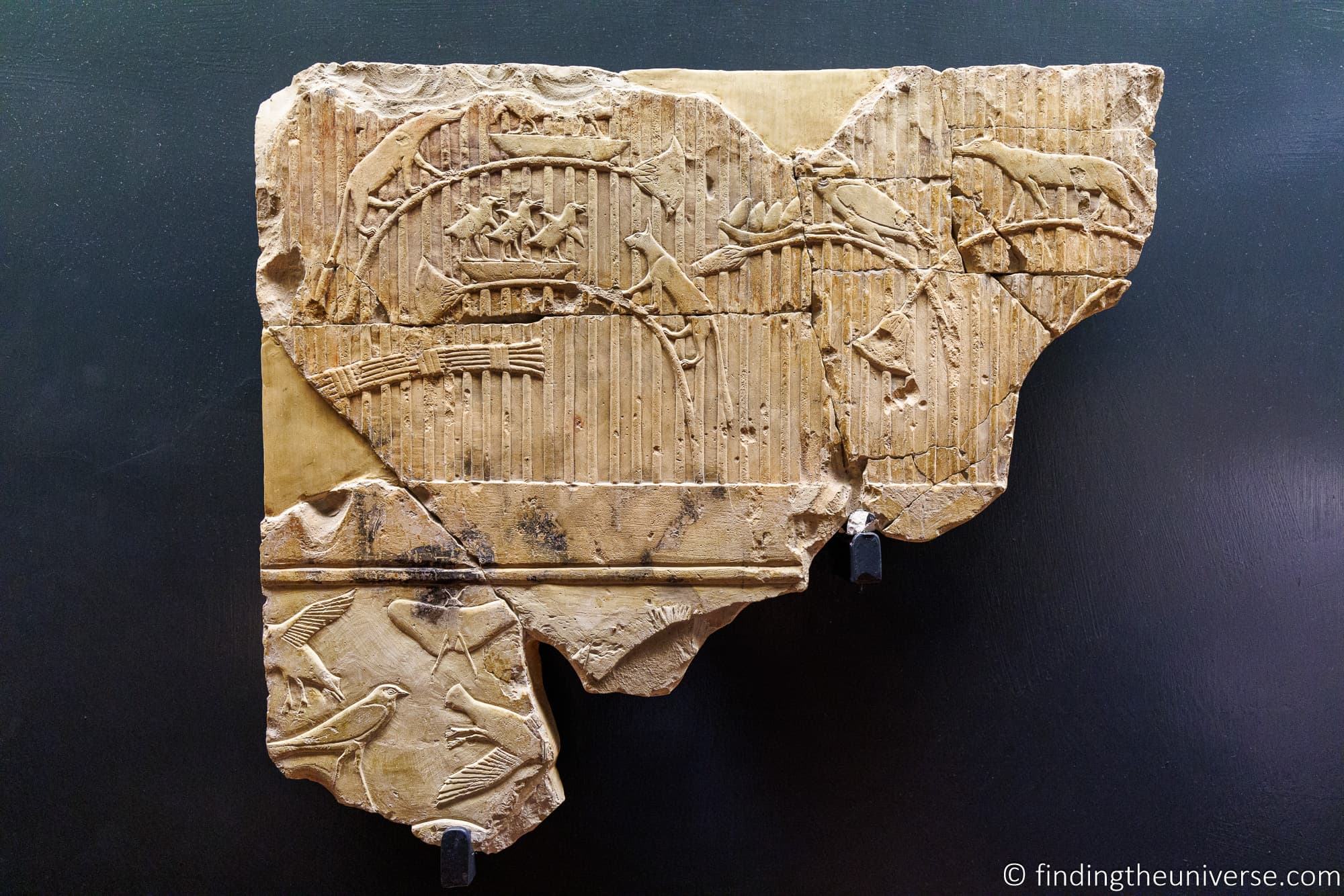
Vatican Historical Museum
Founded in 1973, this is one of the newer museums you can visit at the Vatican. This museum is where you should come if you are interested in learning about the history of the Vatican itself, including the Popes.
Here you will find portraits of Popes over the years, religious paraphernalia and household effects. There are even the various modes of transport used by Popes from carriages to motorcars known as the Popemobiles.
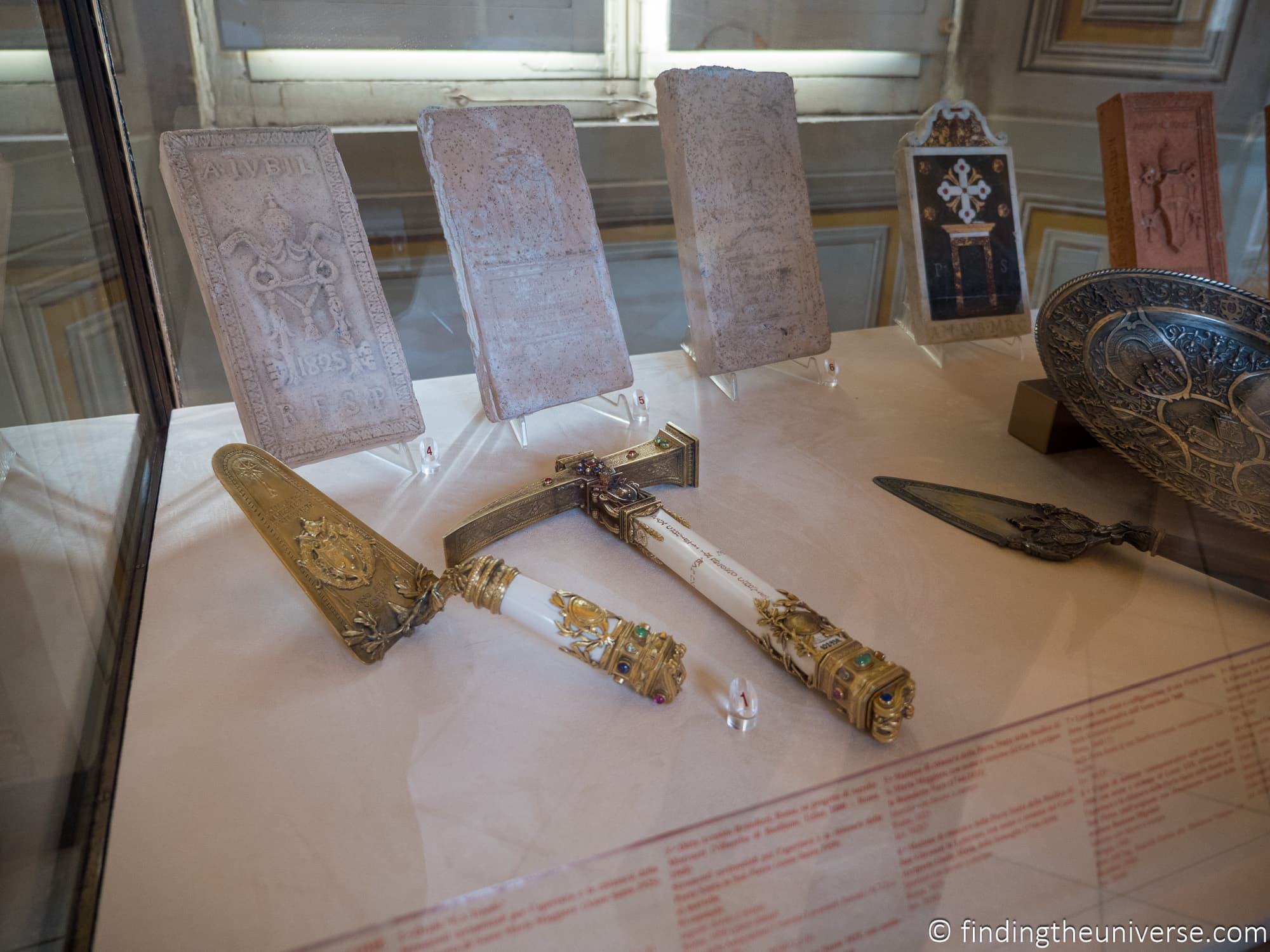
Momo’s Double Spiral Staircase
Even the exit from the Vatican is going to be a highlight of your visit. Once you have finished with the gift shop you are going to head down the stunning double-helix staircase designed by Giuseppe Momo in 1932.
This is actually only one of two double-helix staircases in the Apostolic Palace. The other one was designed by Bramante in 1505. Both the original and the homage to the original by Momo are often referred to as the Bramante staircase, which can be a bit confusing.
The original Bramante staircase though is not normally open to the public.
Still, the 1932 version is absolutely stunning and you will definitely want to capture some images of it before and as you descend.
And now we are done with the highlights of the Vatican Museums! Let’s move on to St. Peter’s Basilica.
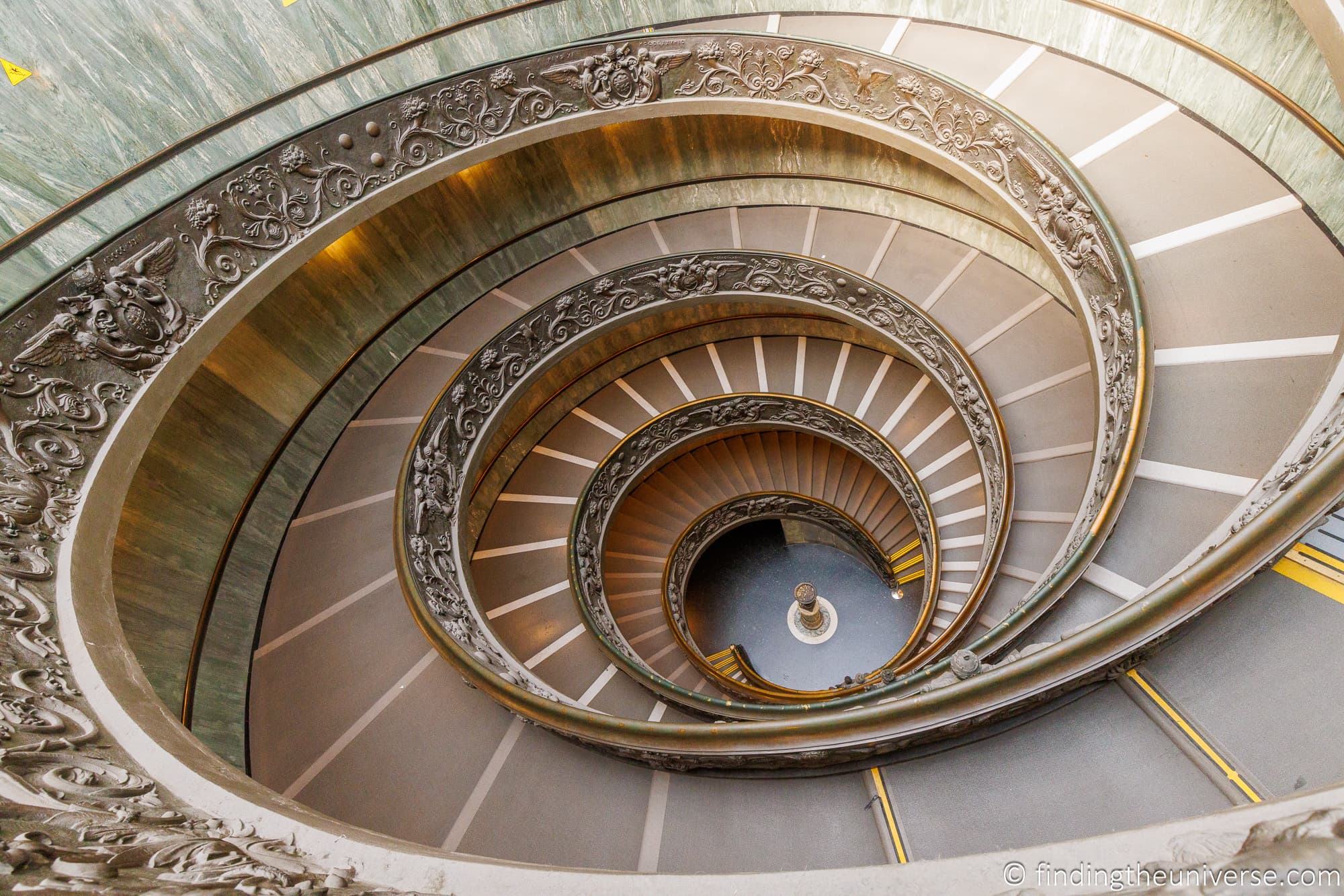
Highlights in St. Peter’s Basilica
As with the Vatican Museums, there is a lot to see and do in St. Peter’s Basilica. However, we do have some favourites that we recommend you include when you visit.
High Altar & Bernini’s Canopy (Baldachin)
The centrepiece of any church is normally the altar, and St. Peter’s Basilica is no exception. Whilst the basilica is home to at least 15 altars, the High Altar is naturally the most impressive.
This is situated directly underneath the dome of the basilica, and above what is said to be the resting place of St. Peter himself.
The most impressive part of the High Altar has to be the incredible sculpted bronze canopy (known as a Baldachin) designed by Bernini. This soars almost 100ft (30 metres) above the altar itself, with four helical columns presided over by four massive angels.
It’s hard to miss, and definitely something you will want to see in St. Peter’s Basilica.
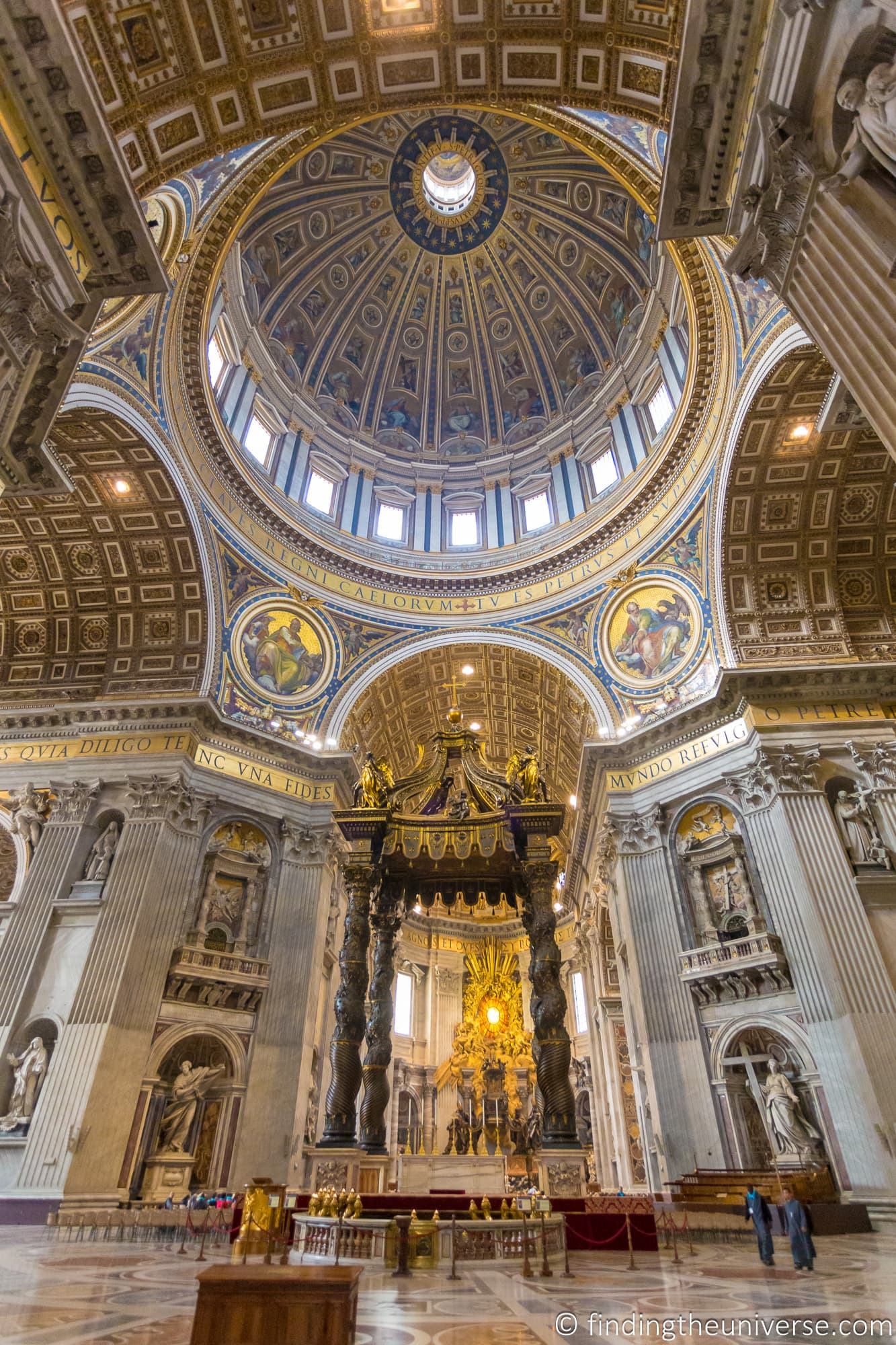
Chair of St. Peter
The Chair of St. Peter, also known as the Throne of Saint Peter, is a wooden throne which is one of the more important relics in St. Peter’s Basilica.
The original wooden chair was believed to have belonged to St. Peter himself, and today it is displayed above the second major altar in the basilica, which is found in the apse of the basilica behind the main altar.
The chair is enclosed in a sculpted bronze encasing which was designed by Bernini, and which is itself an important artwork.
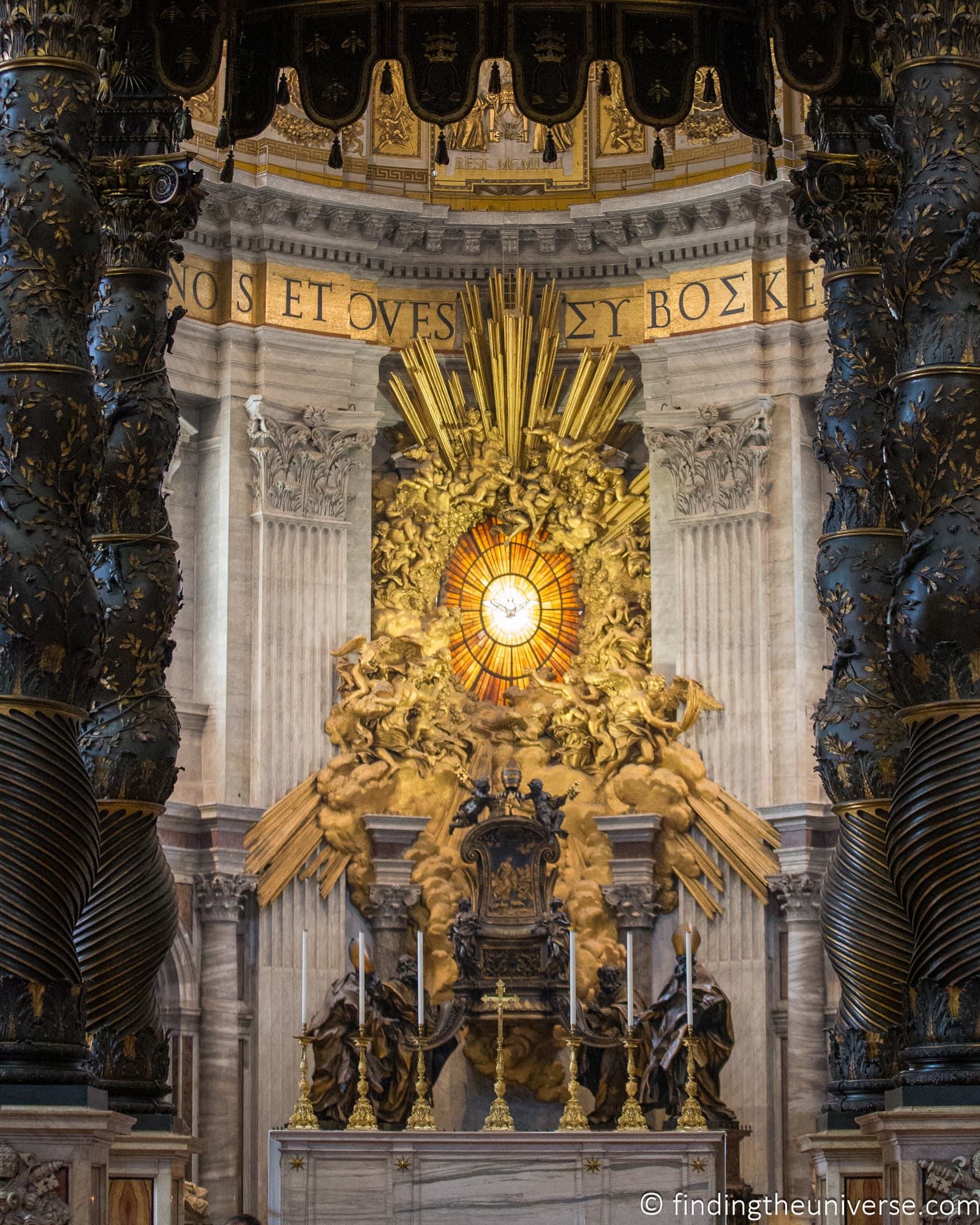
Michaelangelo’s Pietà
The Madonna della Pietà, often just referred to as La Pietà, is one of the many sculptures created by the Renaissance master Michaelangelo. It’s particularly noteworthy as it’s the only piece he ever signed.
It is also, of course, a masterpiece. The sculpture, which dates from the late 15th century, depicts the Virgin Mary holding the body of Jesus following his death. It is remarkably lifelike and beautifully detailed.
The Pieta is easy to find in Saint Peter’s Basilica, it is in the first chapel to the right as you enter the church.
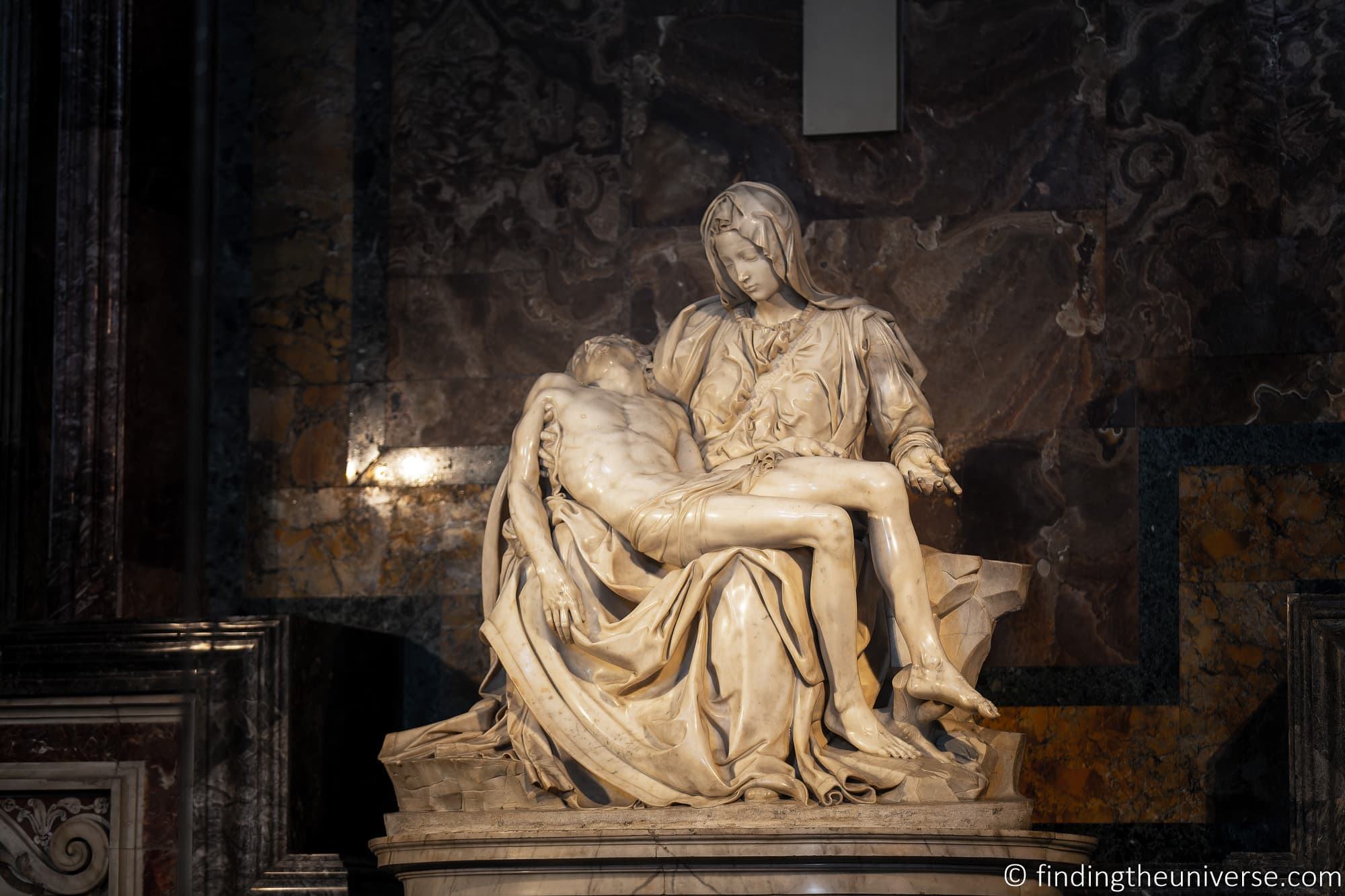
Vatican Grottoes
The Vatican Grottoes (not to be confused with the Vatican Necropolis, both of which are under St. Peter’s Basilica) are where you will find the remains of the original 4th century Basilica. This stood until the 15th century, when the new Basilica was built.
You can visit the Vatican Grottoes for free as part of your visit to St. Peter’s Basilica, and it is well worth doing. This is where you can see sections of the original Basilica, as well as the graves of a great many Popes who were buried down here.
Access to the grottoes is near the high altar at the Pier of St. Andrew. Note that there may be a line to visit the grottoes, and photography is not allowed in the grottoes.
Pope Saint John Paul II’s grave
One of the most well-known Popes of the 20th century was Pope John Paul II, who because a Saint after his death. It is a popular place of pilgrimage, and can be found in St. Peter’s Basilica.
The Pope was originally buried in the Vatican Grottoes, however, following his canonization in 2011 his remains were moved to the Chapel of St. Sebastian.
This can be found on the right of the central nave in the basilica (as you are looking at the High Altar from the entrance), and is next to the niche where you will find Michelangelo’s Pieta.
Pope Saint John Paul II’s grave is under the altar in the Chapel of St. Sebastian, and there is a marble slab marking his grave with the inscription IOANNES PAVLVS PP. II.
Statue of Saint Peter
At many pilgrimage locations around the world you will find some sort of item that pilgrims wish to touch, usually in order to receive a blessing.
In St. Peter’s Basilica, that item is the 13th century Statue of Saint Peter. This bronze statue features St. Peter sitting on a marble chair, holding the keys of heaven in one hand and giving a blessing with the other hand.
Touching (or kissing) the feet of the Saint is a very popular tradition that has likely been going on for hundreds of years. It’s quite easy to find the Statue of St. Peter, it is by a pillar in the centre of the nave near the High Altar. There will also likely be a line of people queuing up to touch the foot of the statue.
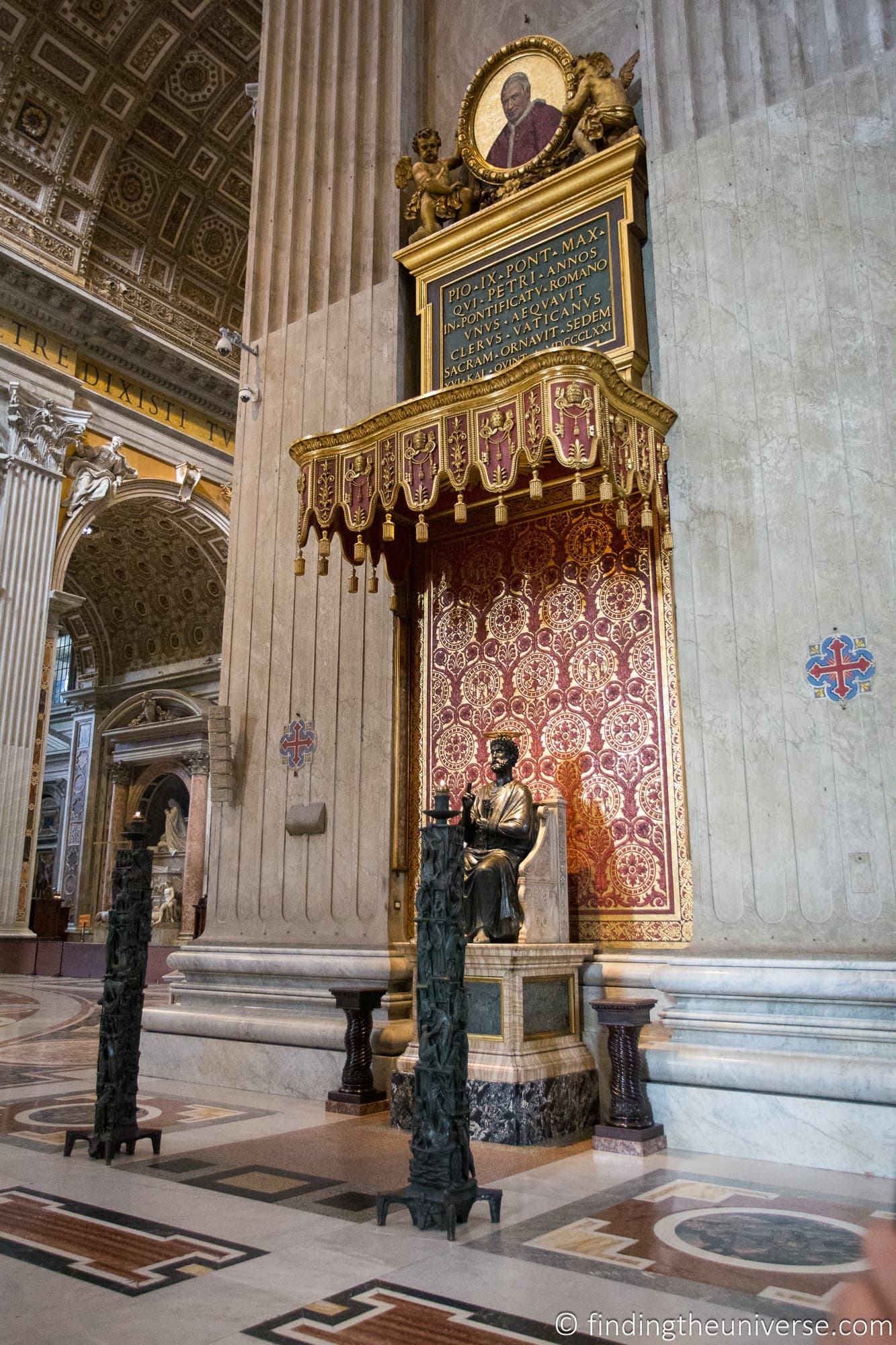
Tomb of Pope Alexander VII
I think it is fair to say that Bernini did quite a lot of work in and around St. Peter’s Basilica! His last great work, designed when he was 80, is the monumental tomb of Pope Alexander VII.
This was commissioned by Pope Alexander VII, who unfortunately died around 11 years before it was actually completed and unveiled in 1678.
The monument itself is created from marble and has six main figures, including Alexander himself. There are then four female statues representing four virtues, Charity, Truth, Prudence and Justice. The last statue features Death holding an hourglass to represent the passing of time and of course mortality.
The monument is found in the south transept of St. Peter’s Basilica.
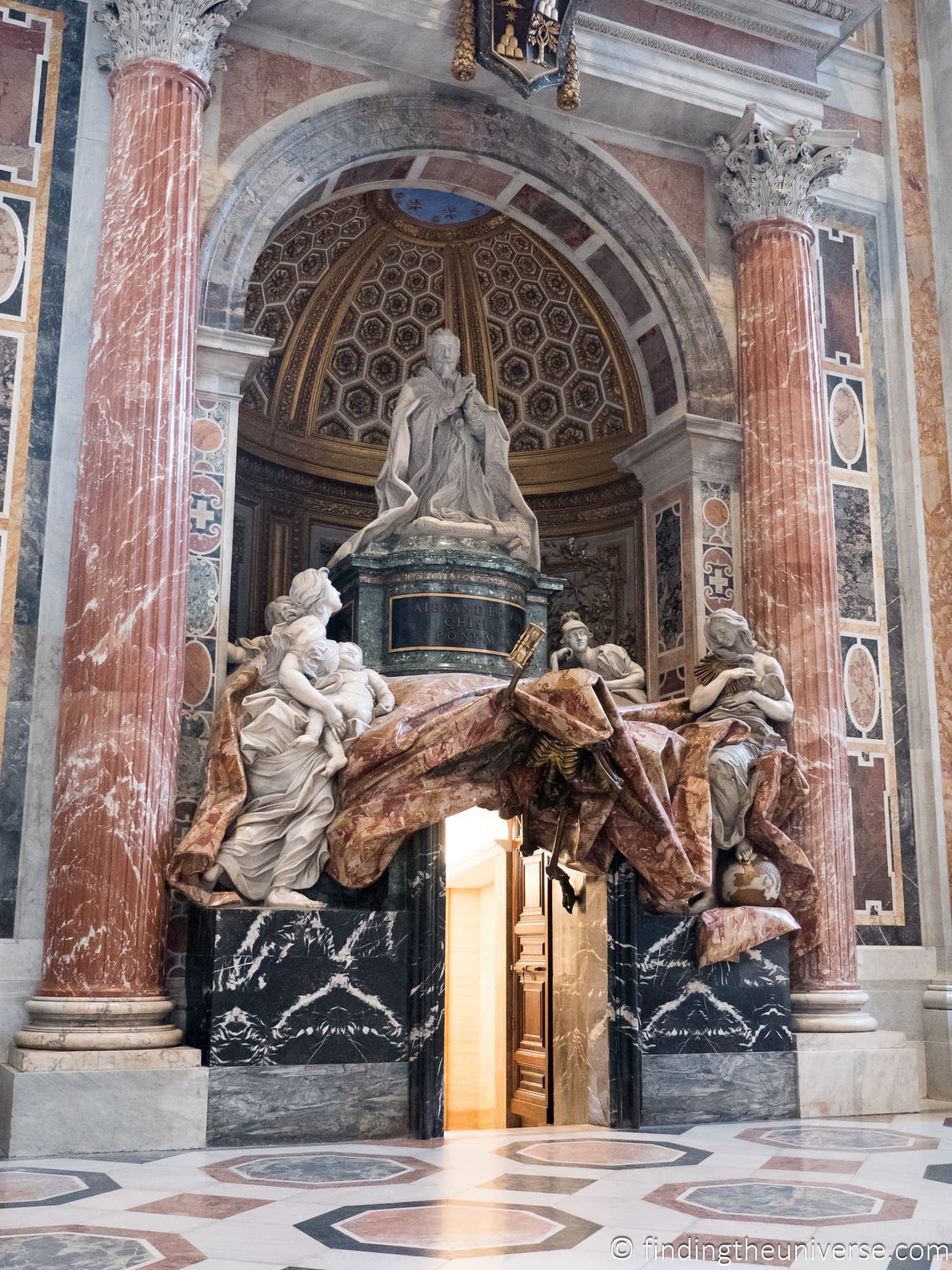
Dome Climb
My personal favourite activity at St. Peter’s Basilica is the climb to the top of the dome. This does have a small fee, which you can pay on site, but the experience is very much worth it.
The dome climb has you climbing from the bottom of St. Peter’s Basilica right to the very top of the dome, from where you will get excellent views across St. Peter’s Square, the Vatican, and most of Rome.
If you are not feeling fit enough to tackle the 500+ steps, you can pay a little bit more to take the elevator. However, this still requires climbing quite a few steps.
We actually prefer the steps over the elevator, not because of the sense of accomplishment, but because the route takes you up through some fascinating parts of the basilica that you otherwise wouldn’t get to see.
And yes, there is a definite sense of accomplishment when you see the view having done all the steps!
Note that you have to pay on site for the dome climb unless you book a tour like this which includes a dome climb. The last time we visited this was a cash only experience and it cost €8 to climb the steps and €10 to take the elevator.
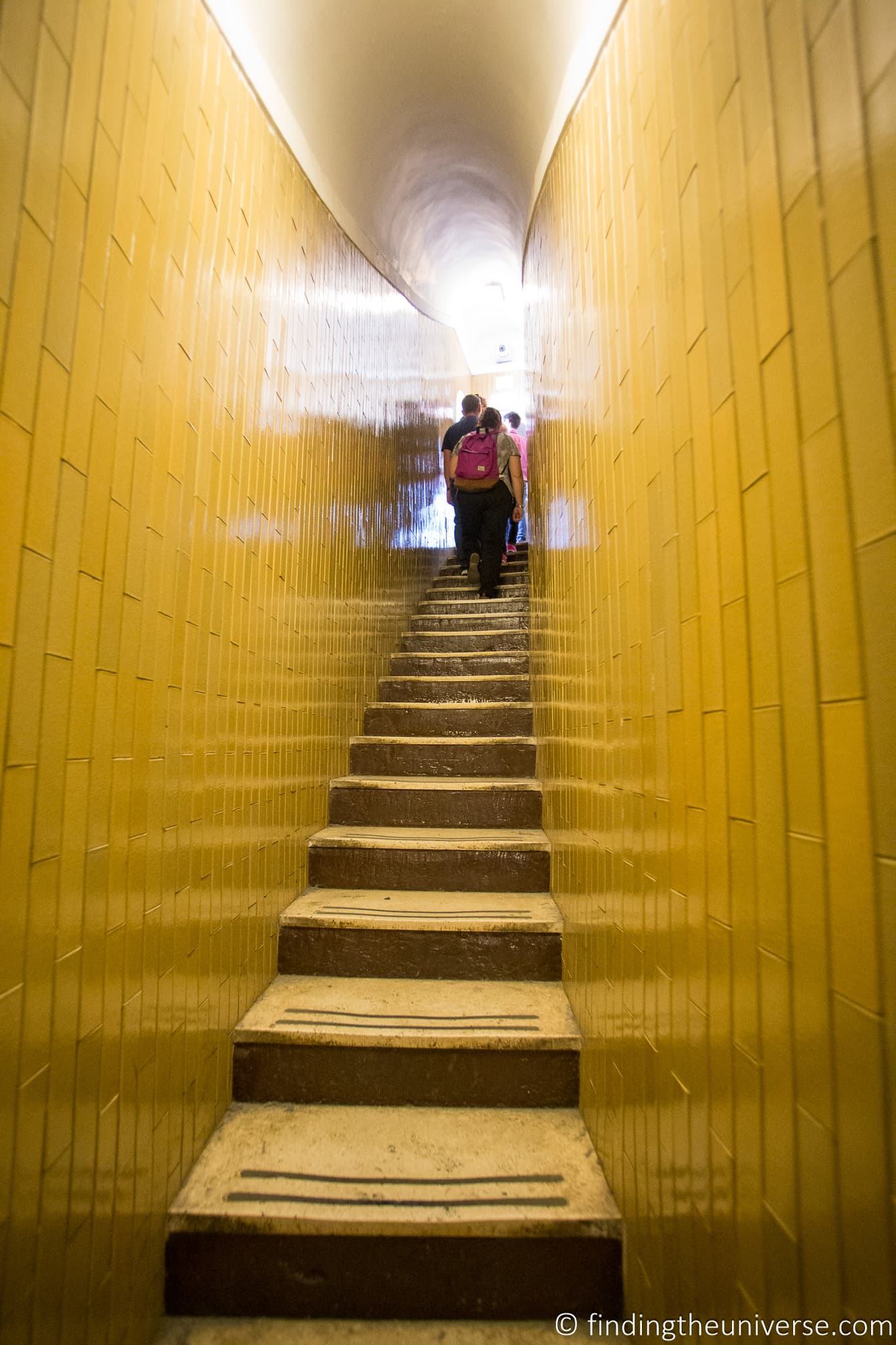
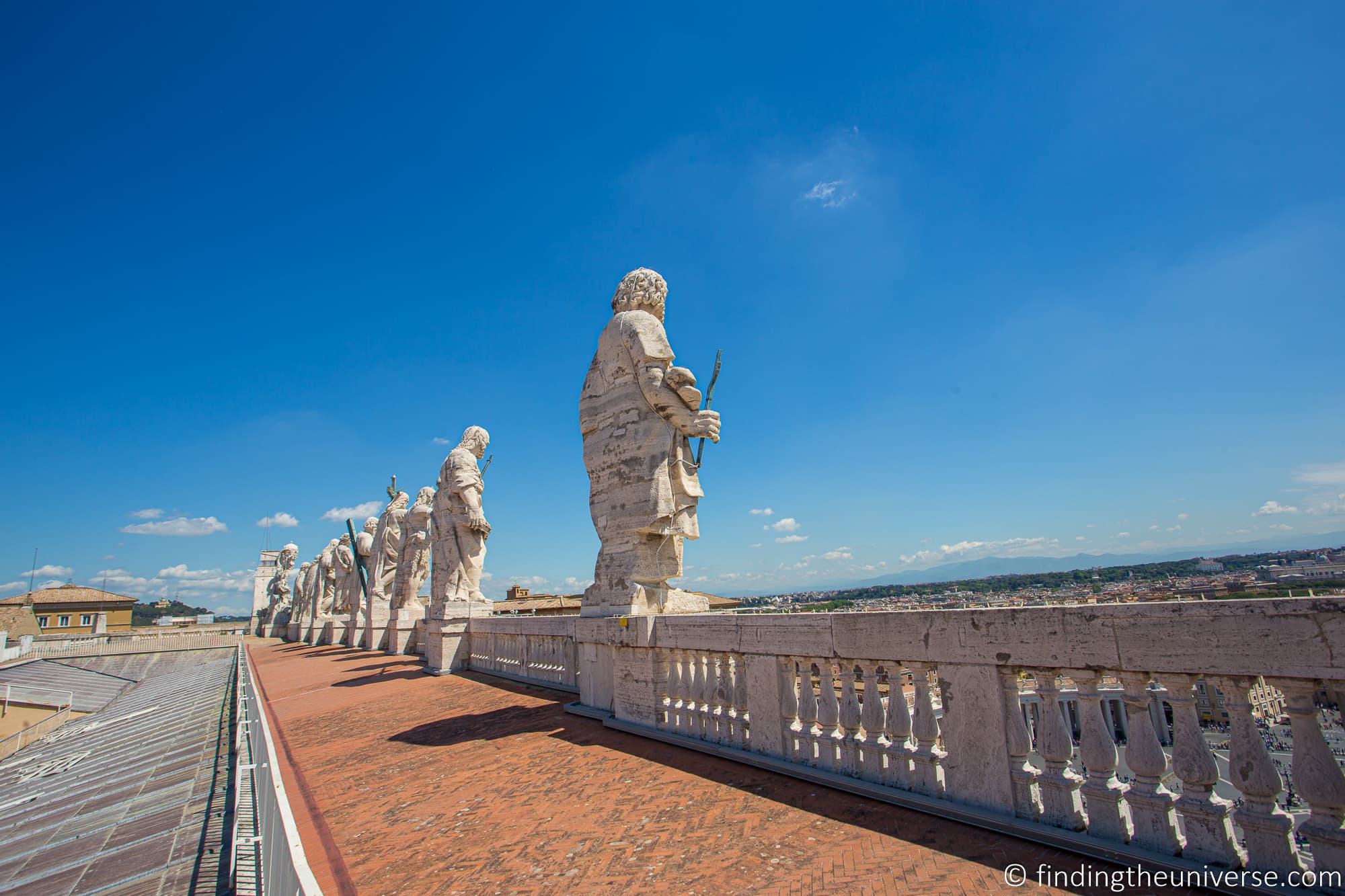
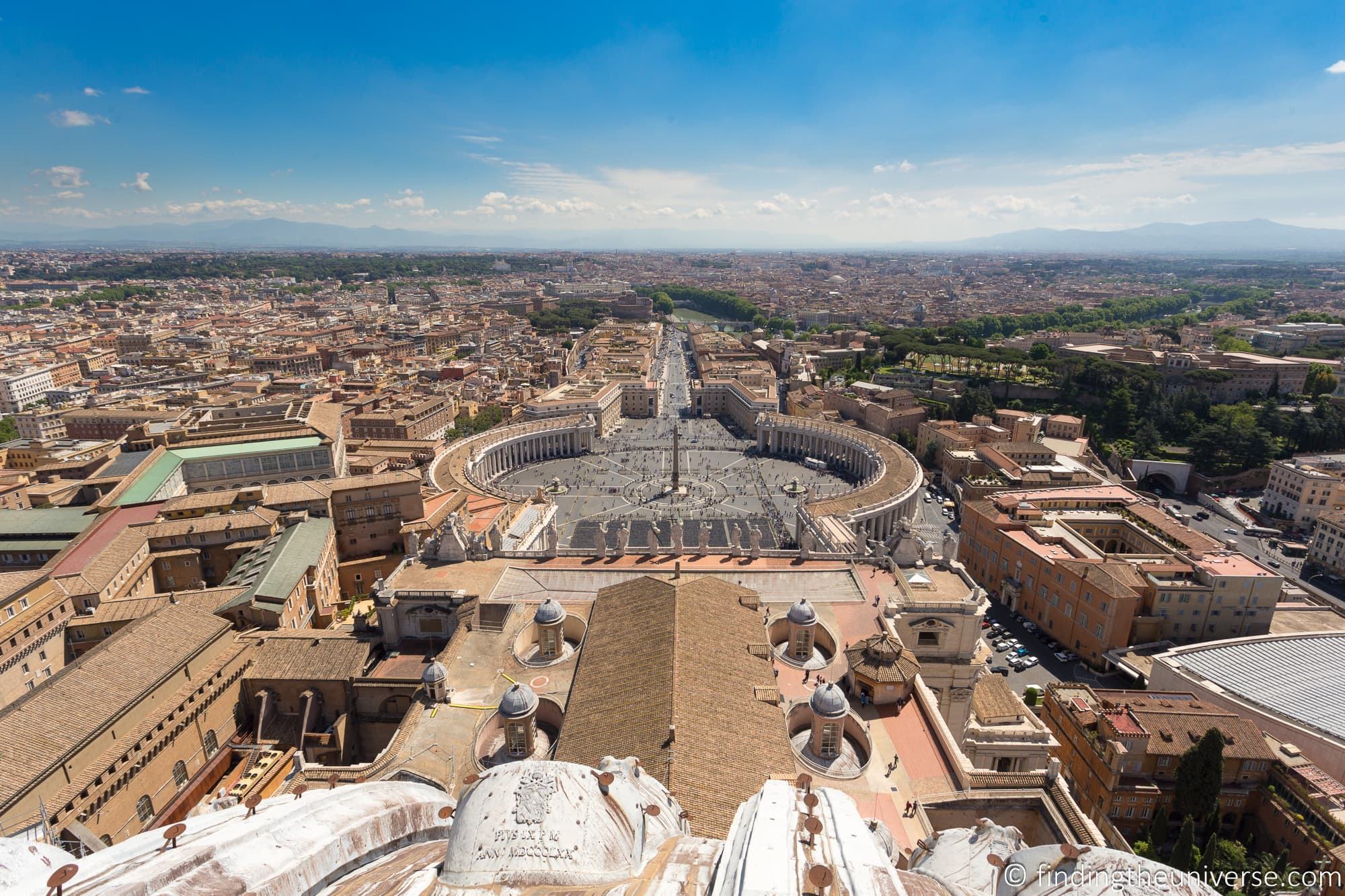
Planning your Vatican Visit
We’ll now cover some important information to help you plan you visit to the Vatican City attractions.
Options for how to visit the Vatican
You have a number of options for visiting the Vatican City attractions. These are as follows:
- Turn up on the day without any tickets and purchase tickets in person (not recommended except at the quietest times of year)
- Book tickets directly or via third-party sites like GetYourGuide or Tiqets
- Book a guided tour with a walking tour company
- Use a Rome attraction pass which includes some of the attractions in the Vatican City
How Long to Visit the Vatican For
As you have probably noted by now, there is a lot to do and see at the Vatican. We’d recommend spending at least four hours here, which will allow you to see the highlights of the Vatican Museums and St. Peter’s Basilica, as well as the main outdoor spaces like St. Peter’s Square.
However, there is plenty to see, so you could easily spend all day here, or even multiple days! But four hours would be our recommended minimum.
Most people do not have days to see everything within Vatican City. So here are some ideas for what to prioritize depending on how much time you have:
Suggested Half Day Vatican Itinerary
If you have half a day to visit the Vatican, we’d suggest the following highlights:
- St. Peter’s Basilica, including the High Altar, Pieta, Statue of St. Peter and Tomb of Pope Alexander VII
- St. Peter’s Square
- Vatican Museums, to include the Pio Clementino Museum, Gallery of Maps, Borgia Apartment, Raphael Rooms, Momo’s Double Spiral Staircase, Sistine Chapel and Pinacoteca
We would recommend either booking a tour which includes the above attractions like this one or this one.
If you would prefer to be self-guided, then we recommend visiting St. Peter’s Basilica first at opening time, and then booking timed entry for the Vatican Museums at opening time. This will ensure you don’t get caught up in the lines for St. Peter’s Basilica, which get longer as the day progresses. You also won’t have to stand in the ticket line for the Vatican Museums.
Suggested Full Day Vatican Itinerary
If you have a full day to visit the Vatican sights then you can take your time and have more of a leisurely experience.
In this case we’d probably recommend something like the following:
- St. Peter’s Basilica, including the High Altar, Pieta, Statue of St. Peter, Tomb of Pope Alexander VII, the Grottes and Dome. You may also consider advance booking a Necropolis Tour.
- St. Peter’s Square
- Break for lunch / coffee
- Vatican Museum, to include the Pio Clementino Museum, Gallery of Maps, Borgia Apartment, Raphael Rooms, Momo’s Double Spiral Staircase, Vatican Historical Museum, Sistine Chapel and Pinacoteca
Again, you could look at booking tours of both of these attractions. Timing wise, this will depend a little on the time of year you visit. In the summer months the Vatican Museums can get very hot, so you might want to do this in the morning and then visit St. Peter’s Basilica in the afternoon.
Tips for Pilgrims & Seeing the Religious Highlights
If you are visiting the Vatican as a pilgrim, then you will likely want to prioritize the religious highlights of the Vatican City.
Our recommended activities would be:
- Attending mass at St. Peter’s Basilica
- Attending a Papal Audience or Sunday Blessing if the Pope is in residence
- Visiting St. Peter’s Basilica, including the Necropolis where St. Peter is buried
- Visiting the religious highlights in the Vatican Musuems, including the Vatican Historical Museum
- Visiting the museum gift shop which offers a number of religious items including rosaries and crucifixes.
You may also consider booking a specific tour which focuses more on the religious highlights and history of the Vatican attractions.
Can you Visit the Papal Apartments at the Vatican?
You cannot visit the private Papal Apartments where the current Pope lives. However, previous Popes have lived in different areas of the Apostolic Palace, and some of these areas can be visited as part of a visit to the Vatican Museums.
Two stand out locations in the Vatican Museum which were former Papal Apartments are the Raphael Rooms and the Borgia Apartments. These can both be visited as part of your Vatican Museums ticket.
Can You See the Pope at the Vatican?
When the Pope is in residence, it is possible to actually see him if you plan ahead.
The best option to see the Pope at the Vatican is to attend either a Papal Audience or a Papal Mass. These are free events, you just need to book a ticket.
You can also catch a glimpse of the Pope during the Sunday Blessing, or Angelus. When the Pope is in Rome he appears at his Papal Palace window at noon on a Sunday for around 15 minutes to bless those in St. Peter’s Square.
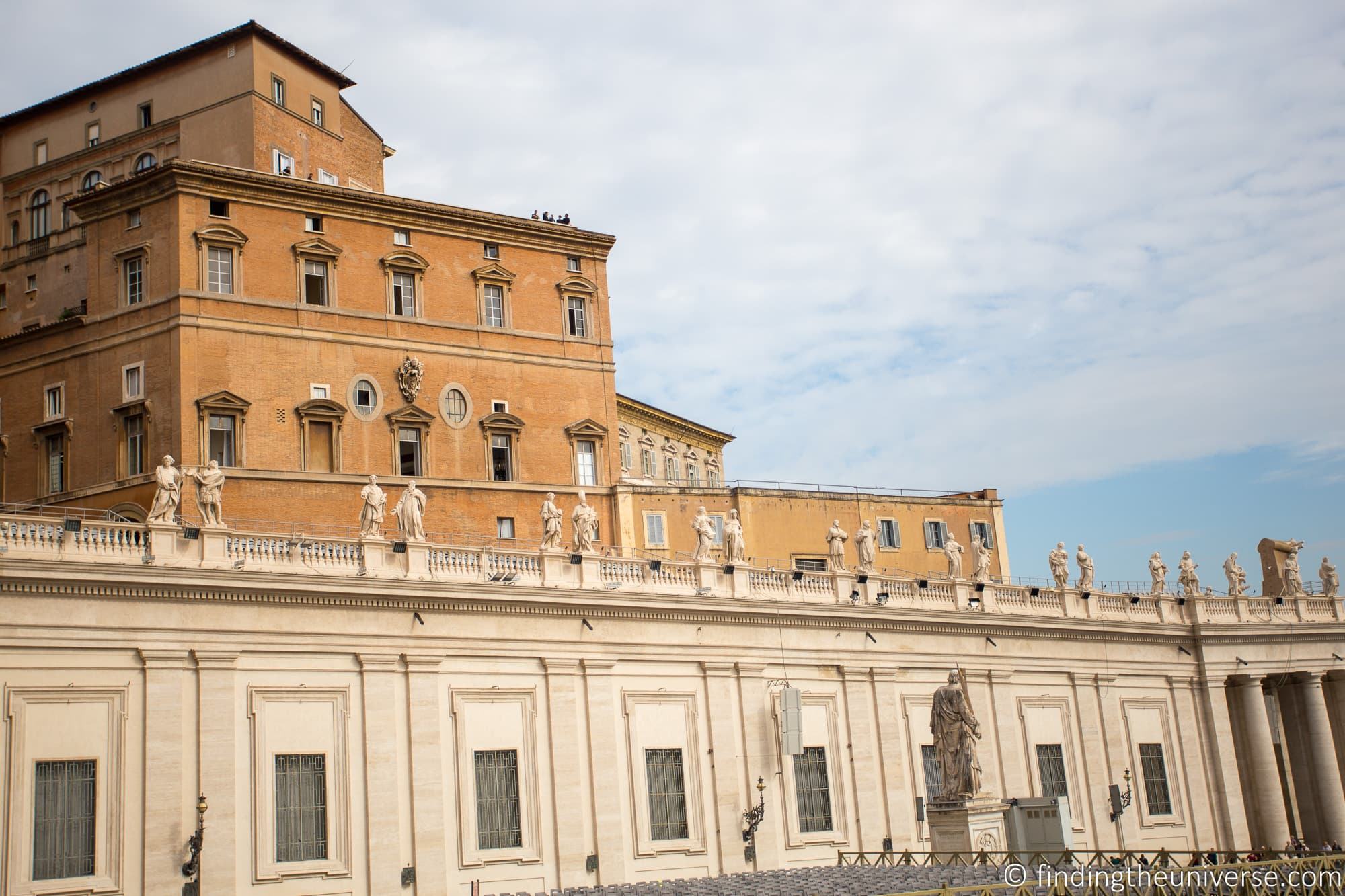
Where is Castel Gandolfo?
You may have heard of Castel Gandolfo, or the Papal Palace of Castel Gandolfo to give it its more formal name. This was long used as the Pope’s summer residence, but it is not found in Vatican City. It’s actually 16 miles (25 km) southeast of Rome, overlooking Lake Albano.
The Palace is a 135-acre complex of buildings and gardens, found in the town of Castel Gandolfo. The current Pope does not use it as his summer residence, but many previous Popes have.
The good news is that you can actually visit Castel Gandolfo and tour the Papal Palace and Gardens. You can either do this yourself, or you can book a tour from Rome which includes transport and access to the gardens and palace.
The Vatican Museums sell tickets for a tour which includes a tour of the Vatican Museums, Vatican Gardens, a return train trip and a tour of the Palace and Gardens. Other companies also do tours, including this tour with Take Walks and these options on GetYourGuide.
Vatican Ticket Information
Below we’re going to cover everything you need to know regarding getting tickets for the Vatican City attractions. This will cover which attractions you need tickets for, how much tickets cost, where to get them and more!
Do You Need a Ticket for the Vatican?
You do not need a ticket to visit the Vatican City State.
However, many of attractions and activities do require visitors to have a ticket or to be part of a tour, which includes:
- Vatican Museums & Sistine Chapel
- Vatican Necropolis
- Vatican Gardens
- Papal Audience / Papal Mass
- St. Peter’s Basilica Dome
We recommend booking tickets in advance where possible to avoid disappointment.
How Much does it Cost to Visit the Vatican?
Prices for the attractions inside the Vatican City vary depending on exactly what you want to see. However, you can see an idea of prices for the attractions as follows.
Prices are correct as of March 2023.
Vatican Museums Ticket Price
There is an entry fee for the Vatican Museums. This is as follows:
- €17 if booked in person at the ticket office (not recommended due to the length of the lines!)
- €17 + €5 booking fee (€22 total) if booked on the official Vatican tickets website (recommended option)
- From around €26.50 via a third-party site such as GetYourGuide (check prices here) or Tiqets (see prices here).
St. Peter’s Basilica Ticket Price
St. Peter’s Basilica is free to visit, although there are some passes which include fast-track entry such as the Rome Tourist Card. Alternatively, you can book a guided tour which includes fast-track entry.
In busier months these can definitely be worth it as the lines for entry can be very long.
You can also pay for additional activities as follows:
- Sacristy & Treasury Museum of St. Peter’s Basilica (€5)
- Dome climb €8 (stairs), €10 (elevator)
- Official 1hr audioguide €5
Vatican Necropolis Ticket Price
The Vatican Necropolis can only be visited on a guided tour. This costs €13 per person as of 2023. See the entry on the Vatican Necropolis for booking instructions.
Note the last time I booked this tour it included some discounts on St. Peter’s Basilica activities, including the museum, audio guide and dome entrance. These discounts were sent to me by e-mail after I booked the tour.
Papal Audience / Papal Mass Ticket Price
Tickets for the Papal Audience and Papal Masses are free and there is no booking fee. See the section on tickets for the Papal Audience and Papal Mass for booking instructions.
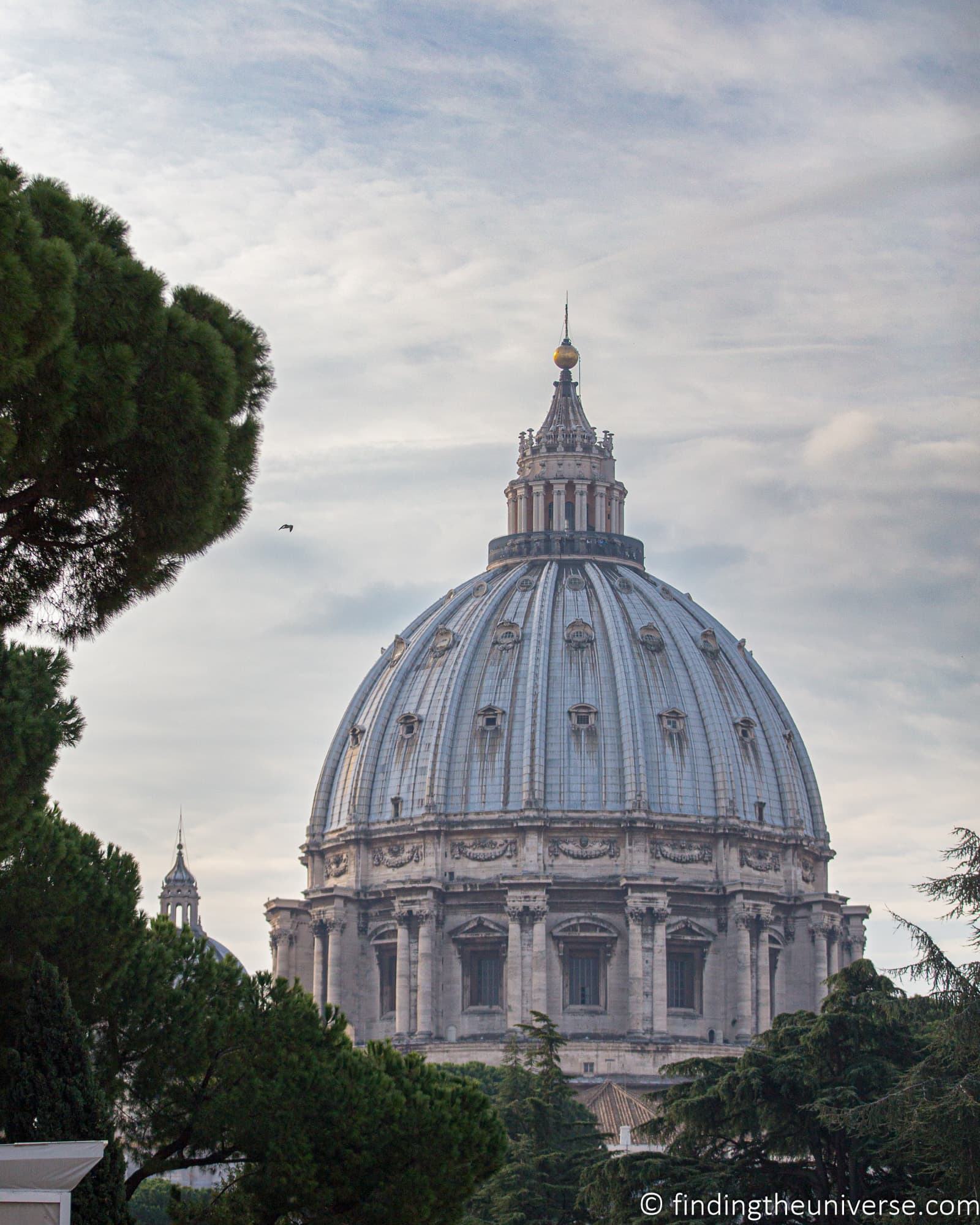
Where to Buy Vatican Tickets
As covered above, some of the attractions in the Vatican require tickets. There are various options for purchasing tickets for these attractions, as follows.
Where to Buy Vatican Museums Tickets
Normally the first place you should check for tickets for the Vatican Museums is on the official website here. These tend to be the best value tickets and the website has a range of ticket options including basic entry tickets, guided tours, and tickets which include locations like the Vatican Gardens.
We also recommend checking ticket options on third-party sites, and we specifically recommend either GetYourGuide (check prices here) or Tiqets (see prices here).
Whilst prices on third party sites can be higher, they sometimes have more availability as well as more flexible cancellation policies (depending on the ticket type). So they are definitely worth checking.
Vatican Museum Tickets Sold Out? You still have options to visit the Vatican!
The Vatican Museums & Sistine Chapel are a very popular attraction, and they do have capacity limits. That means tickets can sell out, especially at busier times of year.
The good news is that even when tickets have sold out on the official site you still have options. These will be slightly more expensive, but often come with additional features.
First, check other ticket types on the official site here. Whilst the standard entry ticket might have sold out, other ticket types such as guided tours or tickets with access to other areas of the Vatican may have availability.
Second, check these tickets on Tiqets. They are pre-purchased so they do often have availability even if the official site is sold out.
Next, check the options for Vatican entry on GetYourGuide. There are a range of options, including guided tours like this one which includes St. Peter’s Basilica. This can be a good way to get last minute entry to the Vatican and get a tour as well, which is our recommended way of seeing the Vatican Museums.
Speaking of tours, our favourite walking tour operator in Italy is Take Walks. We’ve done walks with them all over the world, including a number of tours in the Vatican. You can see their Vatican tours here. Again, these might have availability even when entry tickets are sold out.
We hope that one of the above options will allow you to visit the Vatican Museums, even if you are looking for tickets at the last minute.
Where to Buy St. Peter’s Basilica Tickets
St. Peter’s Basilica is free, so there is no need to purchase tickets.
In previous years, there was the option to purchase a skip the line ticket, which allowed you to skip the often very long lines and get into the Basilica more quickly for a fee. This was discontinued in 2022 (although many sites still talk about it).
This ticket type is supposed to return. However, in the meantime, the only option for skipping the lines is to book a tour like this one.
Another option is to book a Vatican tour like this one which also include St. Peter’s Basilica. Some of the Take Walks tours also include St. Peter’s Basilica. You can see all their Rome tours here.
Where to Buy Vatican Necropolis Tickets
The only way to book Vatican Necropolis tickets is to e-mail the Vatican Scavi office at scavi@fsp.va.
In the e-mail you need to provide the exact number of participants, their full names, language of the tour, the dates you are available to visit and your full contact information.
There is more information on the official website here, but the last time we checked it was a little out of date as it mentions faxing, when e-mail is actually the preferred option. When we have booked the tour we have always gotten a response within a day or two.
Where to Buy Papal Audience and Papal Mass Tickets
Papal Audience and Papal Mass tickets are free, however you do need to arrange them in advance of your visit to avoid disappointment.
The tickets are usually easy to come by (except at popular times like Easter), and you have a few options for getting them.
First, you will want to check there is an audience or mass on the date you wish to attend, which you can do on this Vatican page for 2023. Note this page is normally updated around a month in advance.
Next, for advance bookings (recommended) and groups over 10, you need to contact the Prefecture of the Papal Household, which you can do as follows:
- by e-mail at ordinanze@pontificalisdomus.va
- by fax on (+39) 06 698 85863
- by mail at: Prefecture of the Papal Household, 00120 Vatican City State
Include the number of tickets required, the event you wish to participate in, the date you wish to visit, your first and last name, and your e-mail address. You can see this information here on the official Vatican website where there is also a form you can download to make things easier.
If you book in advance, you will still need to collect your tickets in person at the Bronze Door in the Vatican (found under the right-hand colonnade in St Peter’s Square, here on Google Maps), either the day before the event between 3pm and 7pm. or on the day from 7am. We would recommend collecting them the day before if possible.
It is also possible to obtain tickets when you are in Rome, just by going up to the Bronze Door and asking the Swiss Guards. These are of course subject to availability.
For more information on how to reserve tickets and attend a papal ceremony, see this page of the official Vatican website.
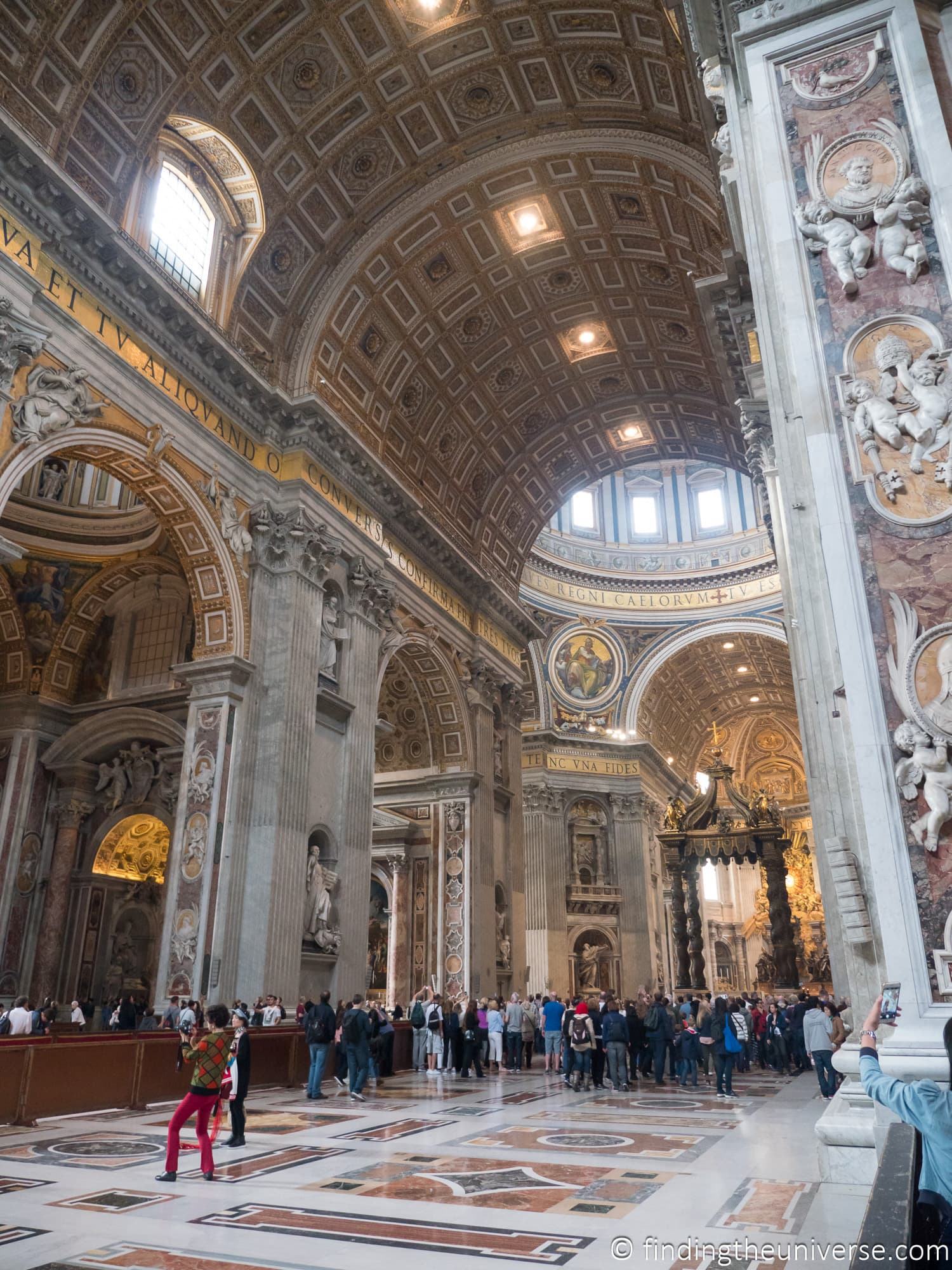
Can you Skip the Lines at the Vatican?
The various attractions at the Vatican have slightly different systems in place for access.
All the Vatican attractions have a security line, which cannot be skipped. However, there are different options for skipping the ticket lines, so we will go through these.
Vatican Museum Skip the Line Access
The main line you can skip at the Vatican is the ticket line. This line can be incredibly long on a busy day, and is definitely one you will want to try and skip.
The good news is that the Vatican Museum ticket line is easy to skip. You can skip this line by purchasing an advance ticket or booking a tour. Both of these include your entry ticket so you can skip the ticket line.
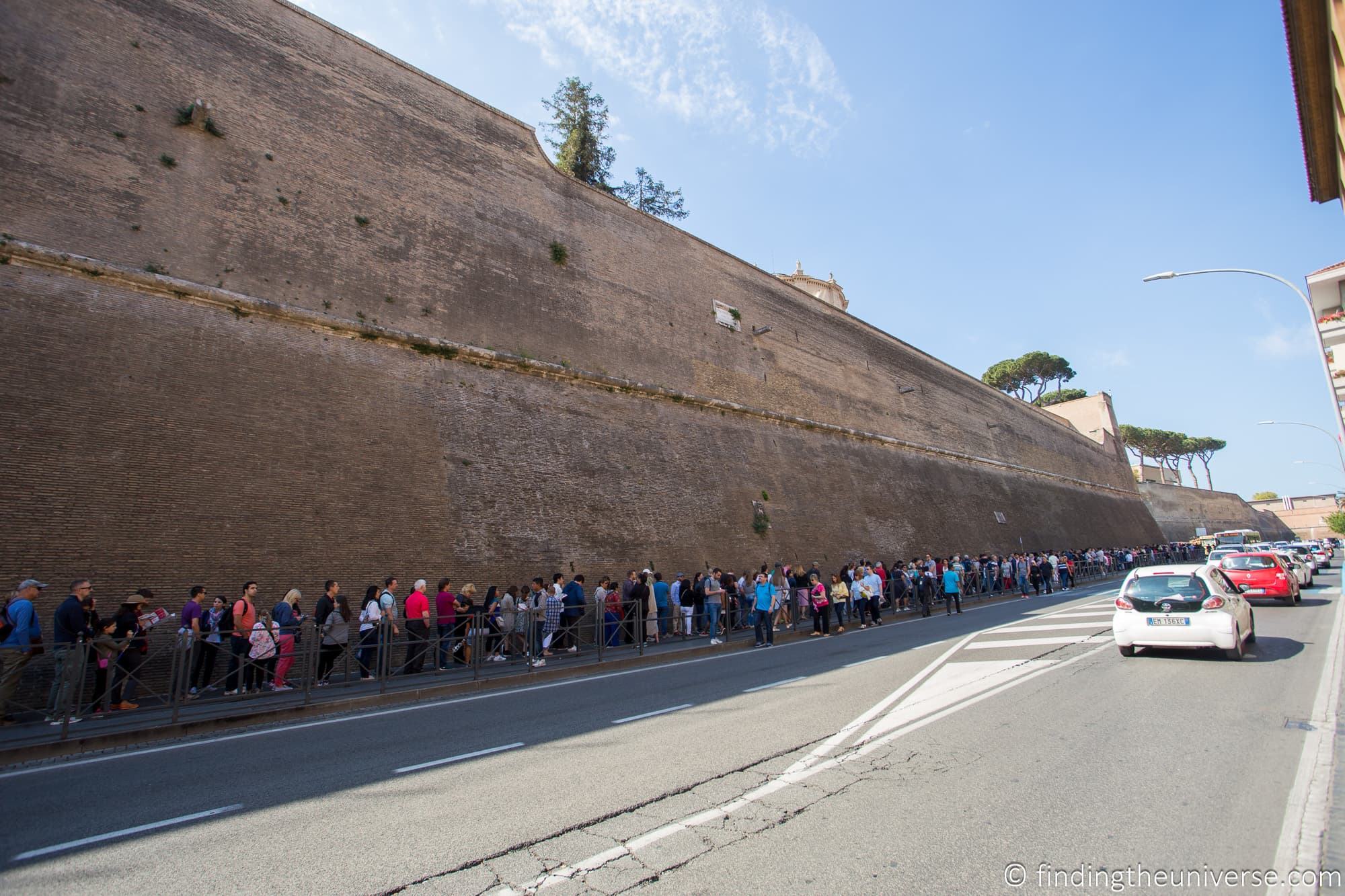
St. Peter’s Basilica Skip the Line Access
As of 2023 there is no fast-track entry for St. Peter’s Basilica. The only line is for security, but this can take a while on a busy day. We’d suggest getting here as early as possible to avoid this line.
The good news is that there are a few options for getting faster entry. Currently, these all involve booking a tour.
First, you can book a combined tour of the Vatican and St. Peter’s Basilica like this. Group tours are able to use a special access corridor that leads from the Sistine Chapel to St. Peter’s Basilica, which entirely skips all the lines and saves you walking around the whole Vatican Museum building.
The disadvantage of this is that you don’t get the opportunity to explore the Vatican Museums at the end of your tour. Most tours which just cover the Vatican Museums end inside the Museum, so you can then go see any additional areas that the tour might have missed.
Another option is to just book a tour of St. Peter’s Basilica like this. Whilst these tours do still have to go through security, entry is normally quicker than the standard entry line.
Finally, you can book the Vatican Necropolis tour. This tour actually ends inside St. Peter’s Basilica, so you skip the main entry line.
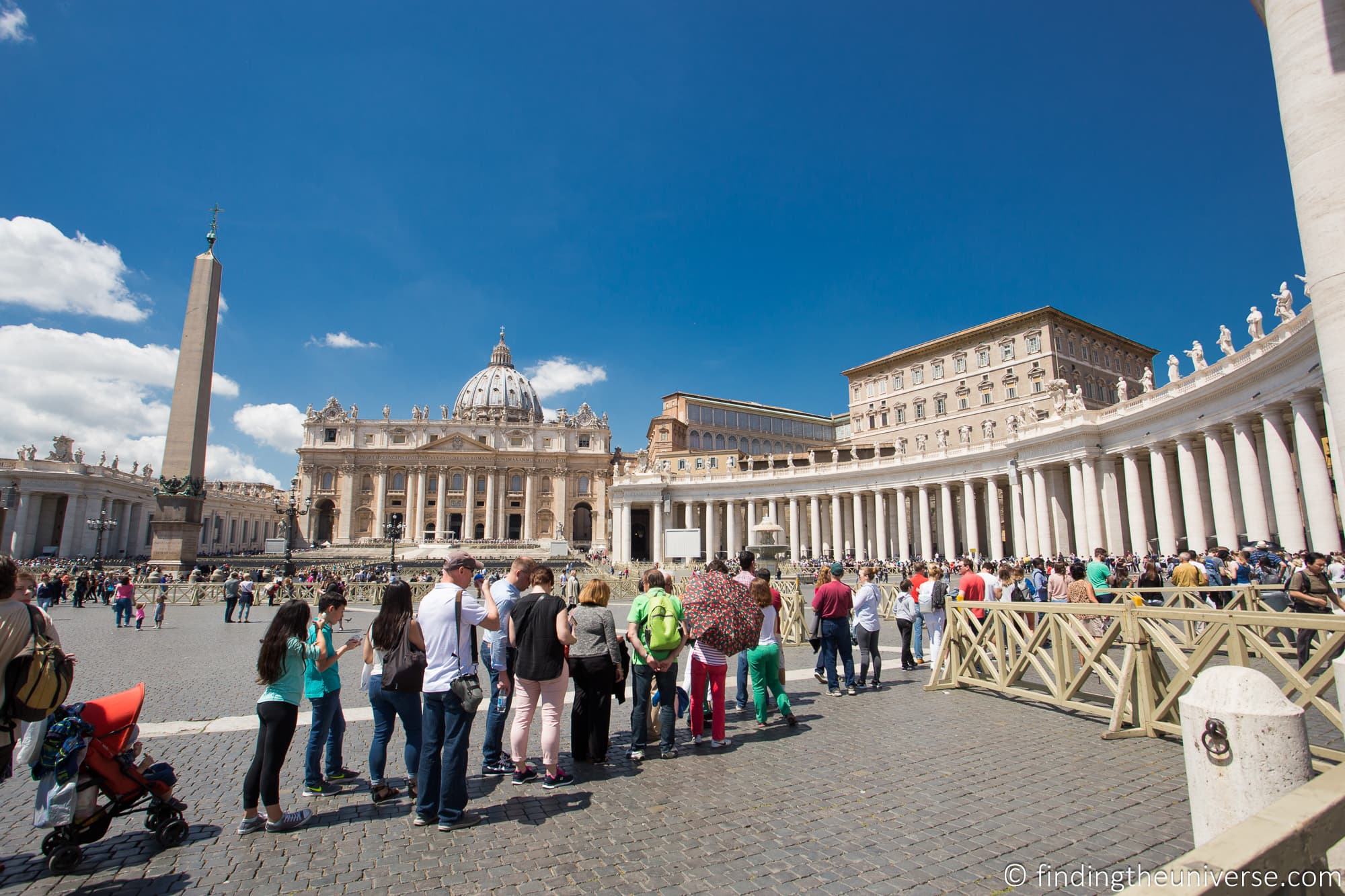
Rome Passes that Include the Vatican
Another option for visiting the Vatican City attractions is to purchase an attraction pass which includes either entry or a guided tour of the attractions. There are a few to choose from, our suggestions to check out are:
The right card for you will depend on what other attractions you plan to visit during your time in Rome and the Vatican.
We’d recommend reading our guides to spending 1 day in Rome, 2 days in Rome and 3 days in Rome for some inspiration to help you decide what other attractions you would like to see.
When is the Vatican Free in 2023?
Visiting the Vatican City is always free. St. Peter’s Basilica is also free, although you can pay for a tour to skip the lines at busier times of year.
The Vatican Museums are normally free on the last Sunday of the month when it is open from 9am – 2pm (last entry 12.30pm). However, beware that the museums, which are normally busy anyway, can be super busy during free days.
Tours at the Vatican
We highly recommend taking a tour of the major Vatican attractions like the Vatican Museums and St. Peter’s Basilica. There is so much to see here, and having a guide can really help you navigate, see the major highlights, and really get a feel for what you are seeing.
Tours of the Vatican Museums
There are a lot of guided tours to choose from at the Vatican Museums. We’d recommend picking a tour that is at least 3 hours long as there is so much to see and a shorter tour might not cover enough.
We’ll go through some of our recommended tour options, although of course there are lots to choose from across a range of price points.
- The Pristine Sistine tour with Take Walks. This is probably our favorite walking tour of the Vatican. It includes early entry, a small group, and it also includes St. Peter’s Basilica. We’ve done walks with Take Walks all around the world and always enjoyed their tours.
- Vatican Key Master Tour. Another tour with Take Walks, this is the most exclusive tour of the Vatican currently available. It basically has you walking through the Vatican and opening it up before anyone else is allowed inside. It’s an incredible experience, but it’s not going to be for everyone. See our full Vatican Key Master Tour review to see if this tour might be right for you.
- This five hour tour covers many of the highlights of the Vatican Museums as well as St. Peter’s Basilica including the Dome.
- This is a shorter 3 hour tour which focuses on the highlights, and includes the Vatican Museums and St. Peter’s Basilica
- This private tour includes the Vatican Museums and St. Peter’s Basilica, and has the option for hotel pickup as well.
- Visiting the Vatican Museums with kids? Check out this private kid-friendly Vatican Museums tour
Of course, there are many more tours to choose from. You can see all the Take Walks Vatican tours here, as well as Vatican tours on GetYourGuide here and Viator here.
There are also full day tours of Rome which cover more than just the Vatican. If that’s of interest, we recommend this 1 day Best of Rome tour from Take Walks which includes the Colosseum, Pantheon, Trevi Fountain and Vatican Museums.
When it comes to picking the right tour, we recommend reading recent reviews and of course picking a tour that matches your budget.
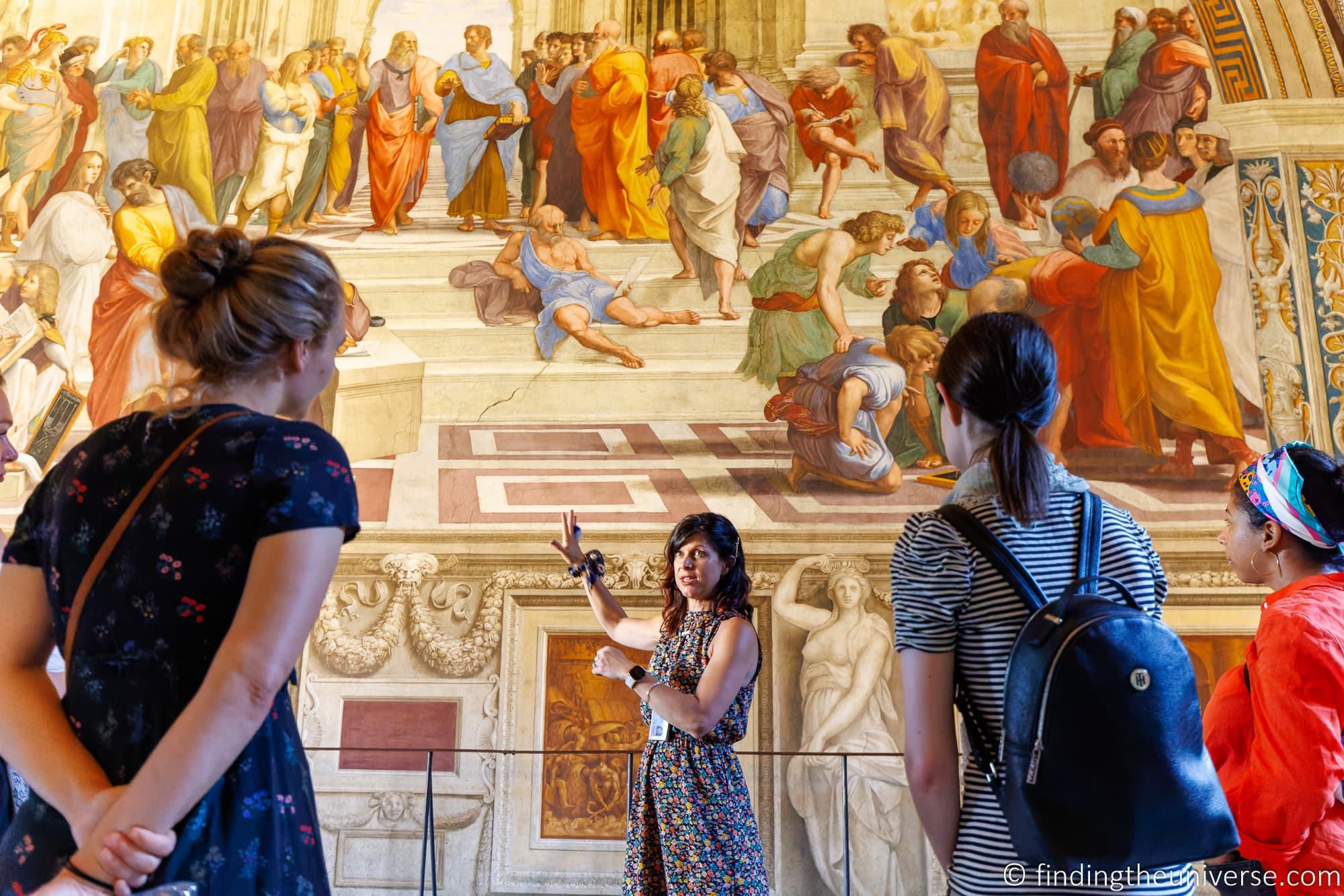
Tours of St. Peter’s Basilica
As with the Vatican Museums, there’s a lot to see in St. Peter’s Basilica, and a tour can be a great way to do that.
Many of our recommended Vatican tours (see above) also include St. Peter’s Basilica, which can be a good option for visiting both locations. However, there are also tours which only visit the Basilica, which is what we’ll focus on in this section to avoid repeating ourselves!
Again, there are plenty more tour options to choose from, including this selection on GetYourGuide and this selection on Viator.
Practicalities for Visiting the Vatican
Now we will go through some practicalities for visiting the Vatican, which covers all the things you need to think about when planning a visit.
Dress Code at the Vatican
Whilst the Vatican State does not have a dress code, the major attractions within it do. These are religious venues, and as such a dress code is strictly enforced.
We have seen many people turned away from entering these attractions because they didn’t dress appropriately. This is not unique to the Vatican, most religious sites across Rome & Italy have similar dress codes in place.
The good news is that the dress code is not hard to get right. Basically, everyone visiting the Vatican needs to have their knees covered and the shoulders, chest area, and upper arms covered. T-shirts are fine.
Men are also required to remove any hats. Women can continue to wear headwear.
Essentially, if you dress modestly, covering your shoulders and knees, you’ll be fine. You’ll want to avoid any short skirts, shorts, or dresses (they need to be knee length or longer). You’ll also want to avoid sleeveless tops, tank tops, crop tops, and low-cut shirts. Tops need to cover shoulders, cleavage, and midriff/belly. This applies for all visitors, including both men and women.
It is also worth noting that the dress code extends to include any visible personal objects or signs (including tattoos) that may offend Catholic morality, the Catholic religion, or common decency.
The Vatican is not specific about precisely what this means, but we’d advise against wearing any clothing which has explicit content, and if you feel you have body art which may offend, to consider covering it up.
You can learn more about the dress code requirements here.
We normally are appropriately dressed when travelling in Italy, but Jess always carries a travel wrap or travel scarf in her day bag just in case we forget or someone is being especially strict. A scarf or wrap is handy as it can be used to cover shoulders and chest or be tied around the waist.
Facilities at the Vatican
There are a number of toilets that are available for public use in the Vatican State. In St. Peter’s Square there are two toilets that are open to the public. There are also toilets inside St. Peter’s Basilica and the Vatican Museums.
For food and drink, there are a number of food and drink options in the Vatican Museums, including self-service options and sit-down options.
You can bring your own snack food and soft drinks into the Vatican Museums, but be aware that you are not allowed to consume food or drink in the actual exhibition halls inside the Vatican Museum.
There are also a number of dining and cafe options around the Vatican area, including some of our favourite coffee shops in Rome and gelaterias in Rome.
Security at the Vatican
All the major attractions at the Vatican have security checks in place, including St. Peter’s Basilica and the Vatican Museums.
There are fairly common-sense restrictions around what is not permitted inside. Items like knives, scissors and other metal tools are forbidden. Alcoholic beverages are also not permitted inside. All these items can however be stored in the Vatican Museums cloakroom which is a free service.
Weapons and hazardous materials are not permitted in Vatican attractions, and these cannot be stored at the Vatican Museums Cloak Room.
Accessibility at the Vatican
Despite being found in some very old buildings, the majority of attractions in the Vatican are set up to be as accessible as possible. Just be aware that parts of the outside are quite uneven, especially St. Peter’s Square which is cobbled, so care will need to be taken.
The Vatican Museums offer free wheelchair hire for those with mobility issues. Mobility scooters and electric wheelchairs are also permitted in most areas (with some exceptions). There are also lifts and ramps for access to most areas. Accessible toilets are also available.
There is a suggested itinerary for those with mobility issues which allows visitors to access the majority of the museum. You can see this on the accessibility page here.
The Vatican Museums also have special services for hearing impaired and both blind and partially sighted visitors. More information on these services can be found on the accessibility page.
St. Peter’s Basilica is also accessible via ramps and an elevator and the interior of the Basilica is flat. There are also accessible toilets near the entrance. However, the grotto and necropolis cannot be accessed by wheelchair users. There is an elevator to the dome area, however there are still some steps to the top of the dome making this not accessible.
If you are visiting the Vatican as a wheelchair user, this company offers wheelchair hire as well as wheelchair friendly guided tours of the main Vatican attractions.
Luggage storage Near the Vatican
Large bags, including rucksacks, suitcases, packages and containers are not allowed in the Vatican attractions. This also includes tripods, selfie-sticks umbrellas and any banners or signs. Walking sticks are permitted.
The Vatican Museums have a free cloakroom where these items can be left. St. Peter’s Basilica does not have a cloakroom, however there are a number of luggage storage options near the Vatican.
Tips for Visiting the Vatican
We have been lucky enough to visit the Vatican a number of times over the years, both as part of guided tours and on our own. From our experiences, we wanted to share some tips for visiting.
Plan your day in advance
You will definitely have an improved experience at the Vatican if you plan your activities in advance. That means booking any tours or tickets in advance.
The Vatican attractions, and especially the Vatican Museums and St. Peter’s Basilica, are amongst the most popular visitor attractions in the world. That means the queues can be long, and they can sell out.
It’s also important to check that the attractions you want to visit are going to be open on the days you plan to visit, and that events like a Papal Audience are not going to impact your visit.
Overall, having a plan for what you want to see and when, and booking any tickets, tours or passes in advance of your visit is going to make for a much more pleasant visit.
Consider a Guided Tour or Audio Guide
We highly recommend taking a guided tour of the Vatican attractions when you visit. A guide will be able to lead you to the highlights and help give you context and information about what you are seeing.
We’ve taken a number of tours of the Vatican, and our favourite tours have all been with Take Walks. Their guides really know their stuff, and their passion always shines through. That said, there are lots of tour operators running Vatican tours, so you should be able to find something that meets your requirements.
If you decide not to take a guided tour, then we recommend at least getting an audio guide. Both the Vatican Museums and St. Peter’s Basilica offer audioguides which are available just near the entrance for a small fee. These are well worth it in our opinion.

Dress and Pack Accordingly
First, you are going to want to ensure you adhere to the dress code for your visit to the various Vatican attractions, as already outlined in this section on what to wear in the Vatican.
The next thing you are definitely going to want to bring is a pair of comfortable shoes. You will be walking a great deal as you explore the Vatican, and a good pair of shoes will ensure your feet are comfortable throughout the day. Check out our guides to the best travel shoes for men and the best travel shoes for women to help you find the right shoes.
You will also want to bring some drinking water so you can stay hydrated, we always travel with a reusuable water bottle. A camera is of course also a must!
It is also a good idea to leave items such as large bags, luggage, food and drinks, knives, laser pointers, tripods, scissors, video cameras, etc. at your hotel if you don’t need them that day. Otherwise, you’ll need to wait in line to check them at the Cloakroom as they are not permitted inside the Vatican Museums.
Be Wary of on-site Touts at the Vatican
When you arrive at the Vatican it is very likely that you will be approached by official looking individuals offering you tours or tickets which might include fast-track entry. They may even try to tell you that you need to book a tour or a ticket with them in order to get entry.
Normally these folks are not affiliated with the Vatican. Instead, they are trying to sell guided tours or pre-bought fast-track tickets. These will generally be at inflated prices.
If you don’t pre-book a ticket for the Vatican Museums and find yourself in the long ticket lines, they will also attempt to persuade you to purchase a fast-track ticket, which will likely be tempting if the ticket line is stretching out of sight around the building.
Our recommendation is to skip the touts entirely, and to plan your tickets in advance. That way, when you are approached, you can just politely refuse their services. If you do happen to turn up at the Vatican without a ticket, I’d suggest finding a coffee shop or similar location with free WiFi and either checking the official website, or using a service like GetYourGuide or Tiqets to book a same day ticket.
Skip the Free Days, or Arrive Very Early
As mentioned previously, the Vatican Museums are free on some days of the year. Whilst these days can be a good way to see the museums without spending any money, they are also incredibly popular. The queues stretch for hours on the free days.
If you really want to visit the Vatican Museums on a free day, then I would advise arriving as early as possible so you don’t have to queue for as long.
Arrive Early
Regardless of whether or not you are visiting on a free day, you will want to arrive early for both St. Peter’s Basilica and the Vatican Museums.
For St. Peter’s Basilica, which is free to visit, this is because the line for security tends to just get longer as the day progresses. The Basilica opens early, so if you can be here at opening time you will be able to skip that lengthy wait.
For the Vatican Museums, if you pre-book your ticket, you will be visiting with timed entry. We suggest booking your entry for as early in the day as possible, especially in the warmer months.
This is because the majority of the Vatican Museums are not air-conditioned, and it gets progressively hotter as the day goes by. If you arrive early, you will be able to explore with fewer people and at more manageable temperatures.
If you are taking a a guided tour, then we suggest booking a tour with early entry for the same reasons, but also so you can experience the museums with even fewer people.
Attractions Near the Vatican
Vatican City is home to a great many attractions, so you definitely won’t run out of things to do. However, if you are planning your time in Rome and want to see some other sights on the same day you might be wondering what other attractions are near the Vatican. Here are some ideas for nearby attractions, ordered by distance.
- Museum of Leonardo Da Vinci – this small museum is dedicated to Leonardo Da Vinci’s life and works. There are no original artworks but it is interesting nonetheless. 5 minutes’ walk from St. Peter’s Square.
- Castel Sant’Angelo – a stunning 2nd century castle, 10 minutes’ walk from St. Peter’s Square
- Piazza Navona – one of Rome’s most famous squares, with a stunning Bernini waterfall as the centrepiece. 20 minutes’ walk from St. Peter’s Square
- Villa Farnesina – a beautiful Renaissance-era suburban villa, found in trendy Trastevere neighbourhood, 20 minutes’ walk from St. Peter’s Square
- Belvedere del Gianicolo – a popular viewpoint which overlooks the city of Rome. 25 minutes’ walk from St. Peter’s Square.
There are of course more sights all around Rome that you can visit, but this should give you some ideas of nearby attractions to consider.
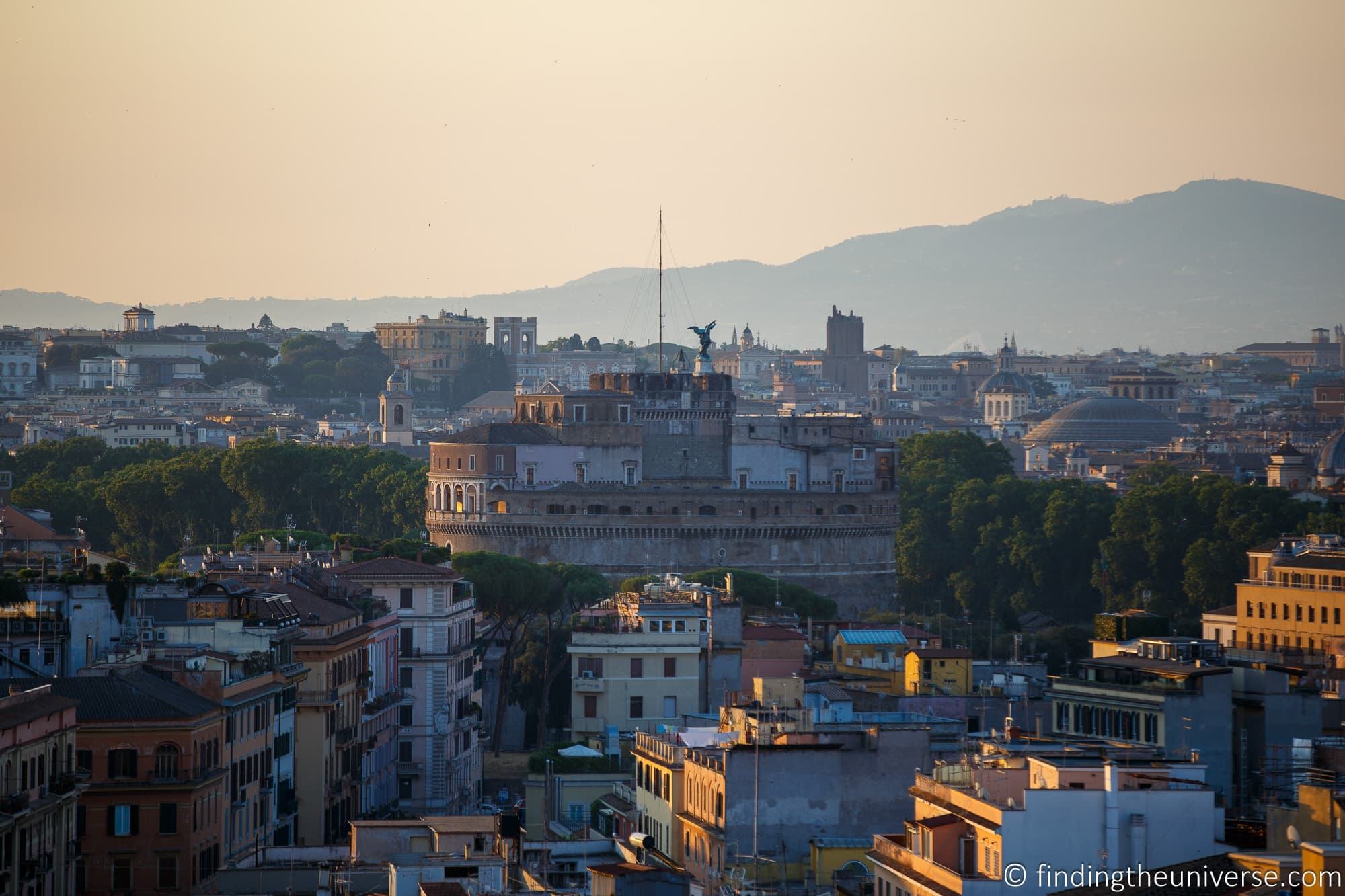
Where to Stay Near the Vatican
There are a lot of accommodation options in Rome, across a wide range of budget and styles. Here, we’ll share some options for accommodation near the Vatican. These are ordered approximately by distance. Prices do vary, so you will want to compare before booking.
We’d recommend booking a hotel with air-conditioning if visiting in the summer especially as Rome can get very hot.
- Residenza Paolo VI – this well-rated four star hotel set in a converted monastery is just moments away from St. Peter’s Basilica. There are lovely views of both the Basilica and St. Peter’s Square from the Terrace, and it’s only 15 minutes’ walk from the Vatican Museums.
- Palazzo Cardinal Cesi – another well-rated four-star hotel just 150 yards from Saint Peter’s Square. The 15th century building has a courtyard garden and a selection of comfortable rooms to choose from.
- Elle Boutique Hotel -this four-star boutique hotel is around 500 yards from St. Peter’s Basilica with views of the Dome.
- Starhotels Michelangelo Rome – another well-review four-star hotel just 500 yards from St. Peter’s Basilica offering classically decorated rooms. There’s also an on-site restaurant.
- Tmark Hotel Vaticano – this four-star hotel is moments from the entrance to the Vatican Museums and about a 10 minute walk to St. Peter’s Square.
- Best Western Plus Hotel Spring House – this well reviewed hotel is just three minutes’ walk from the Vatican Museums and around 10 minutes from St. Peter’s Square
- Hotel Silla – this 2-star hotels offers great value accommodation just eight minutes walk from the Vatican Museums and 13 minutes from St. Peter’s Square. It’s also right next to Ottaviano metro station, for easy access to sights around Rome.
- Villa Agrippina Gran Meliá – this luxury 5* hotel is abouta 15 minute walk from St. Peter’s Square or 25 minutes to the Vatican Museums entrance. It’s also just 10 minutes from the trendy Trastevere region.
Of course, there are many more options. See the listings for accommodation near the Vatican on Booking.com here.
How to Find More Information on Visiting the Vatican?
There are a great many websites with information on visiting the Vatican (including this one!).
I have endeavored to make this site as accurate as possible based on our personal experience and knowledge from multiple visits to the Vatican over many years.
There are of course official sites for the Vatican which I would also recommend reading. These are:
- https://www.vatican.va/content/vatican/en.html – the official Vatican website, which has information on opening times and visiting, attending Papal Audiences, visiting St Peter’s Basilica and more. I’ll be honest, this site can be difficult to navigate and pages are not always available, but it’s the best place to start
- https://www.vaticanstate.va/it/ – the official Vatican State website, which has information on services, live webcams and history. Currently only in Italian as far as we can tell.
- https://www.museivaticani.va/content/museivaticani/en.html – the official Vatican Museums website, where you can purchase tickets, learn about the collection, take virtual tours, and plan your visit. Well worth visiting in advance of your trip to get some ideas for what to see.
Personally, I would suggest starting with the above sites when looking for information on visiting the Vatican and purchasing tickets. You can also see a list of official Vatican websites here.
If you have any questions, we’re also happy to answer them in the comments below.
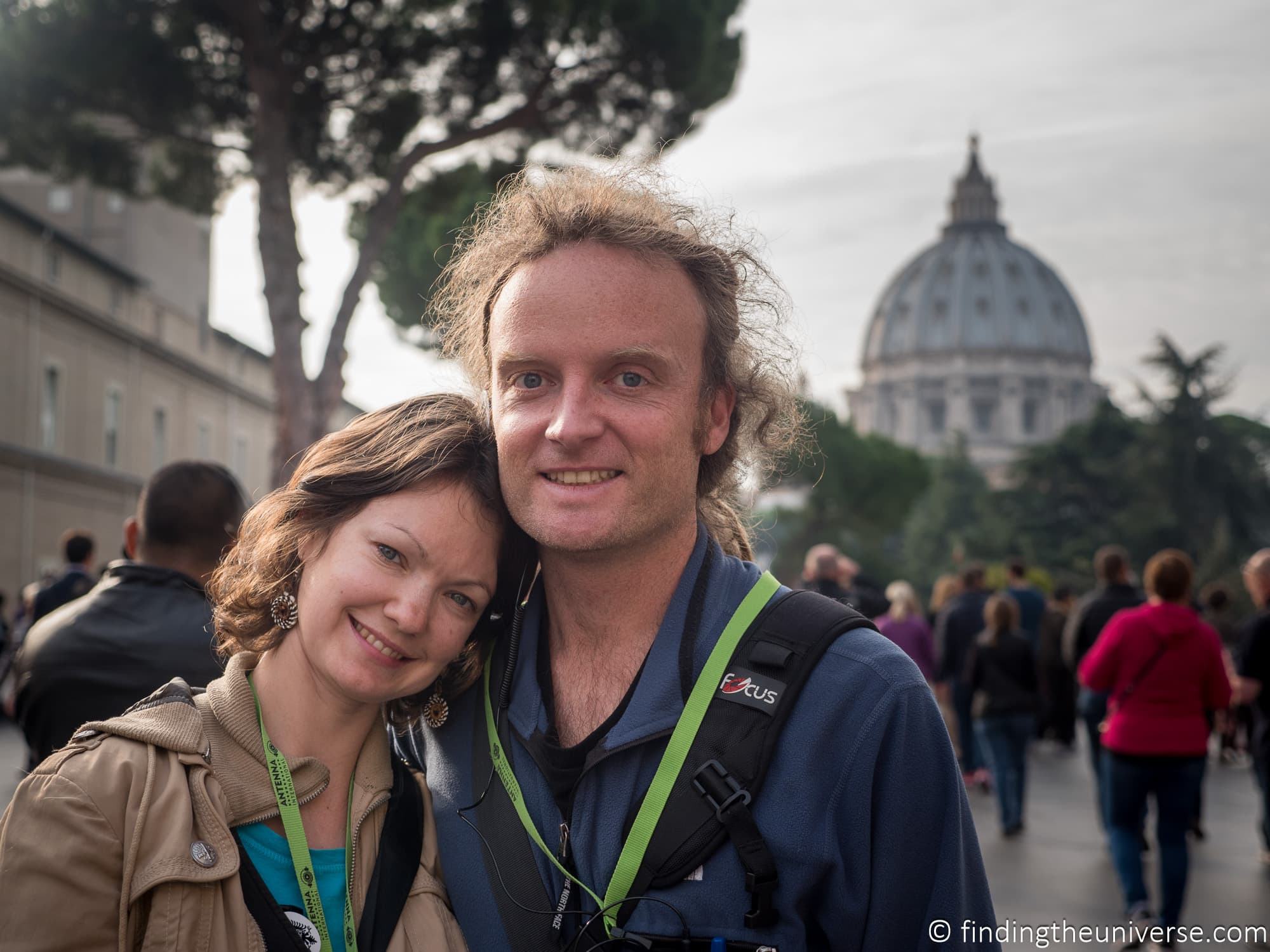
Further Reading for Visiting Rome
That’s it for our guide to visiting the Vatican. We also wanted to share some more guides we’ve put together for Rome, based on our many visits to the city.
We’ve also visited many other parts of Italy, and we’ve included some of these posts below as well, as well as some other resources we think you’ll find useful.
- We have a guide to spending 1 day in Rome, as well as guides for 2 days in Rome and 3 days in Rome, which should help you plan your time effectively. We also have a guide to things to do in Rome in general.
- You can’t visit Rome without trying gelato – the Italian version of ice cream. See all our favourite places to find the best gelato in Rome
- Another popular Italian pastime is drinking coffee, particularly espresso! See some of the best cafes to drink coffee in Rome
- We’ve taken a number of other walking tours in Rome. See our guide to our favourite walking tours of Rome here. We also have a full review of the Vatican VIP Key Master’s tour, which is one of the most exclusive tours of the Vatican you can take.
- We have a detailed guide to visiting the Borghese Gallery in Rome which is one of our favorite art museums in Rome.
- We also have a guide to visiting the Colosseum, which has everything you need to know to plan your visit to this remarkable attraction
- Beyond Rome, we have a guide to Florence, suggested things to do in Milan, and tips for a day in Venice
- We also have a detailed 10 day Italy itinerary to help you plan a trip in this wonderful country
- If you’re planning on visiting Rome in summer, read our tips for visiting a European city in summer to stay sane
- If you’re looking for a physical (or Kindle!) guidebook, we recommend the latest edition of Rick Steves Rome guide, which has lots of practical information to help you make the most of your stay
And that’s the end of guide to visiting the Vatican City and its attractions. We hope you found it useful. As always, if you have any questions or feedback on this post, let us know in the comments below!

